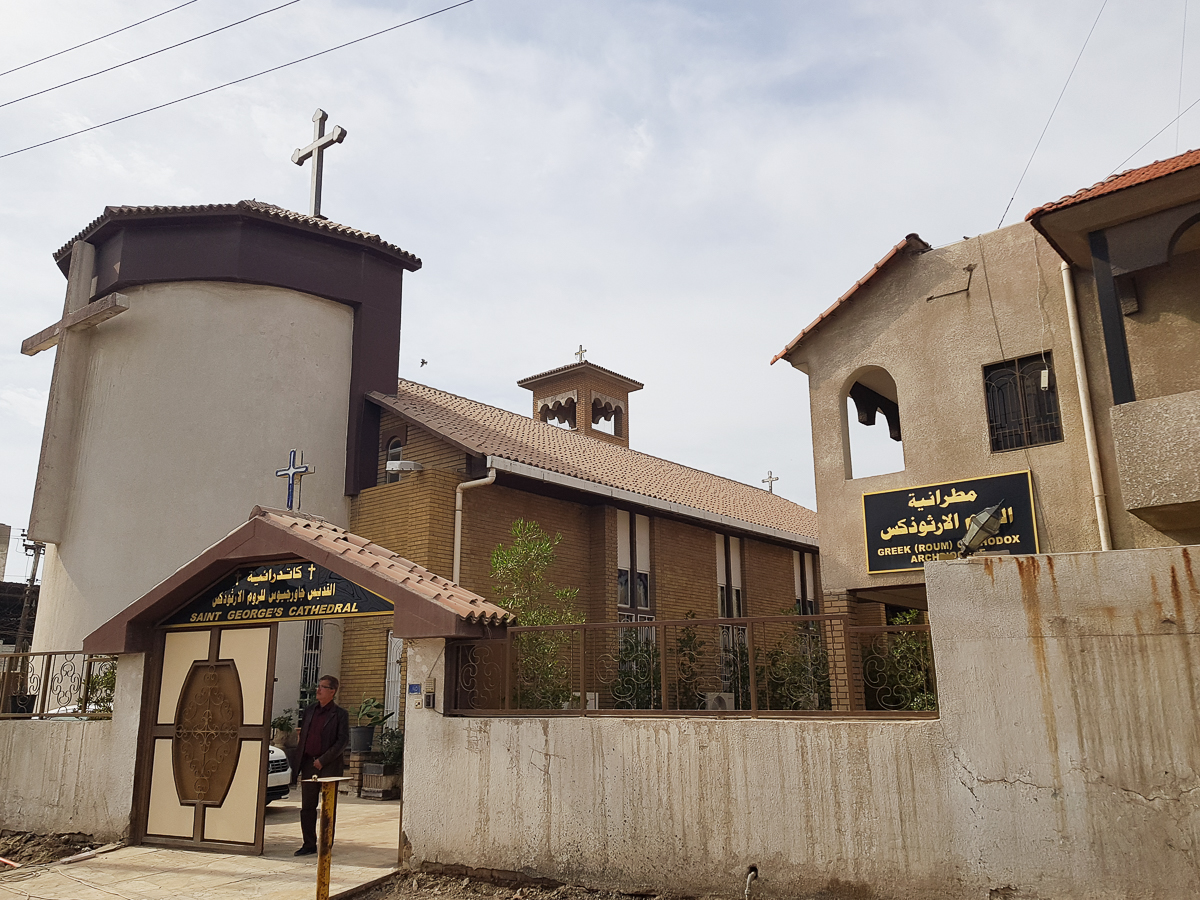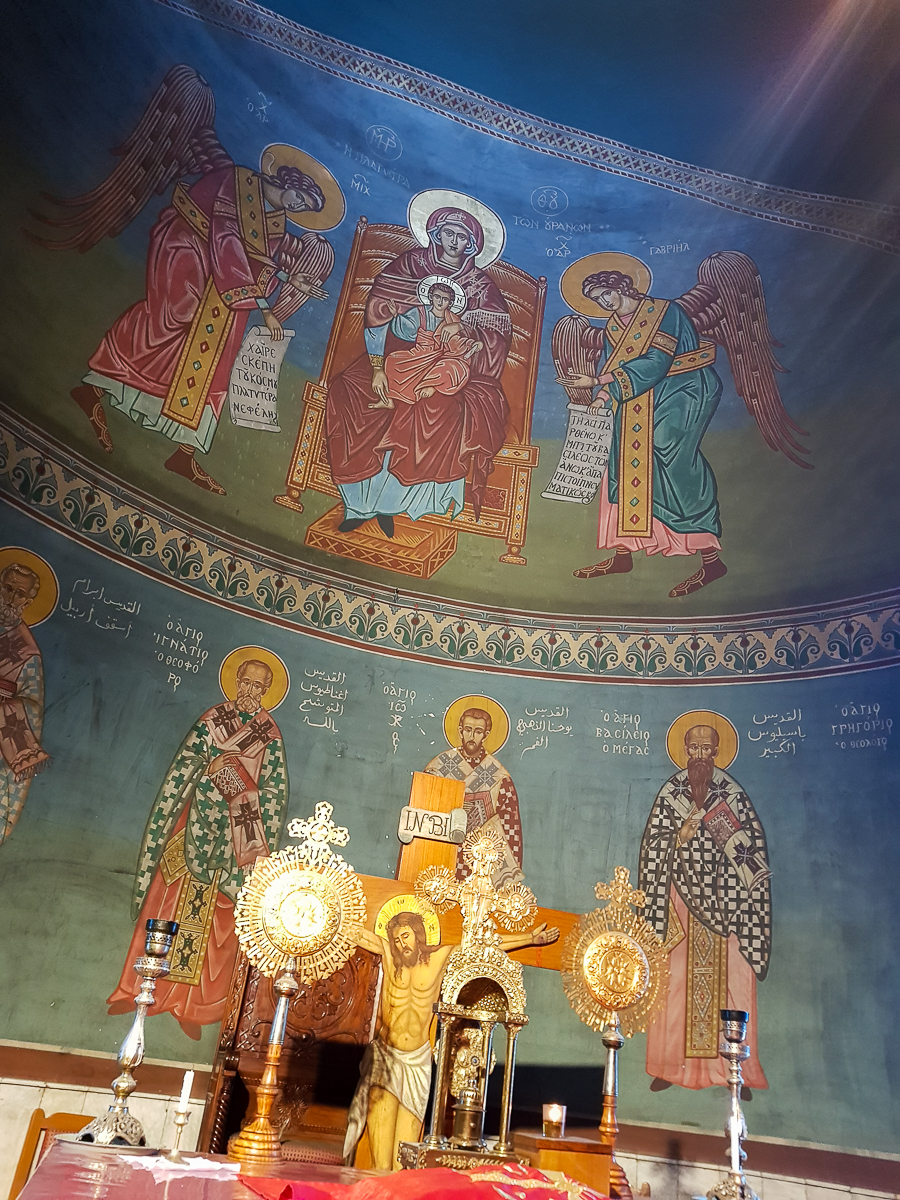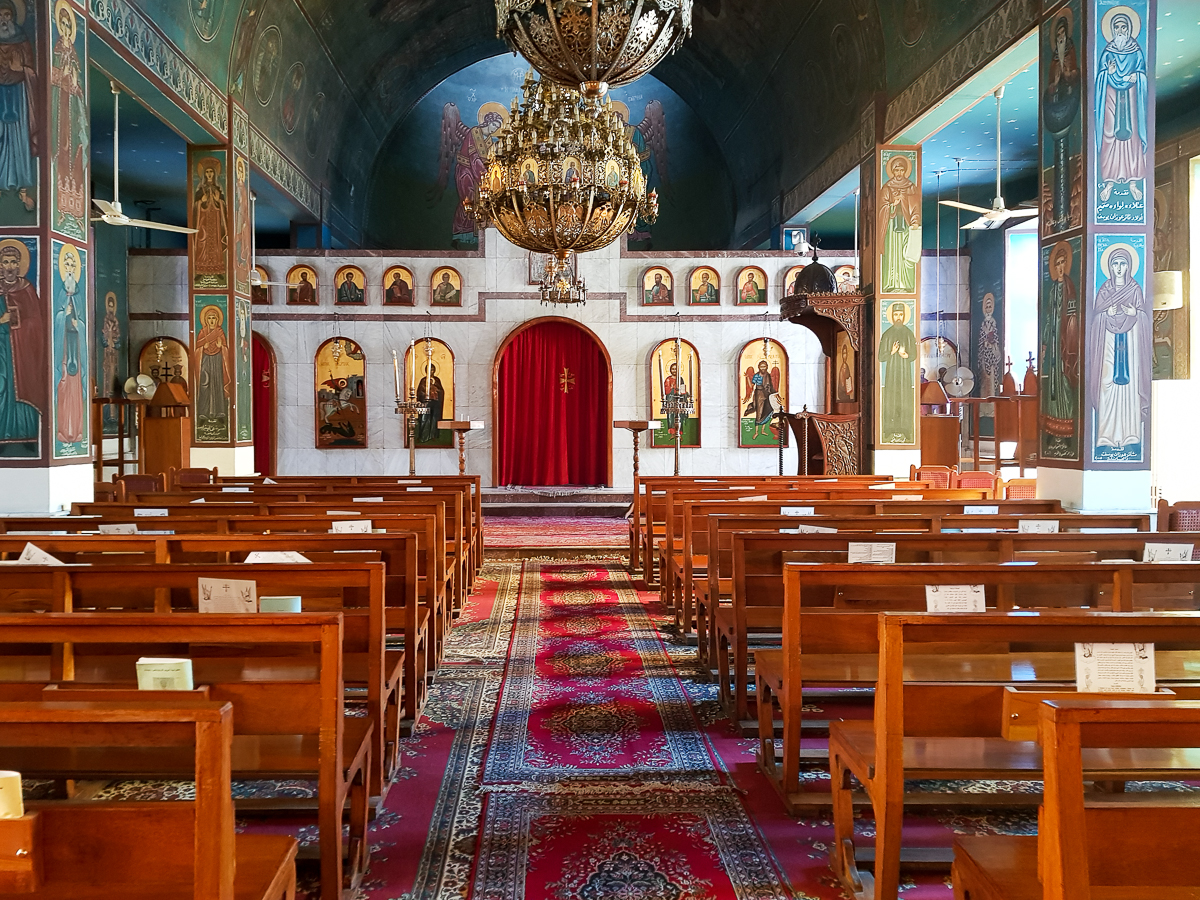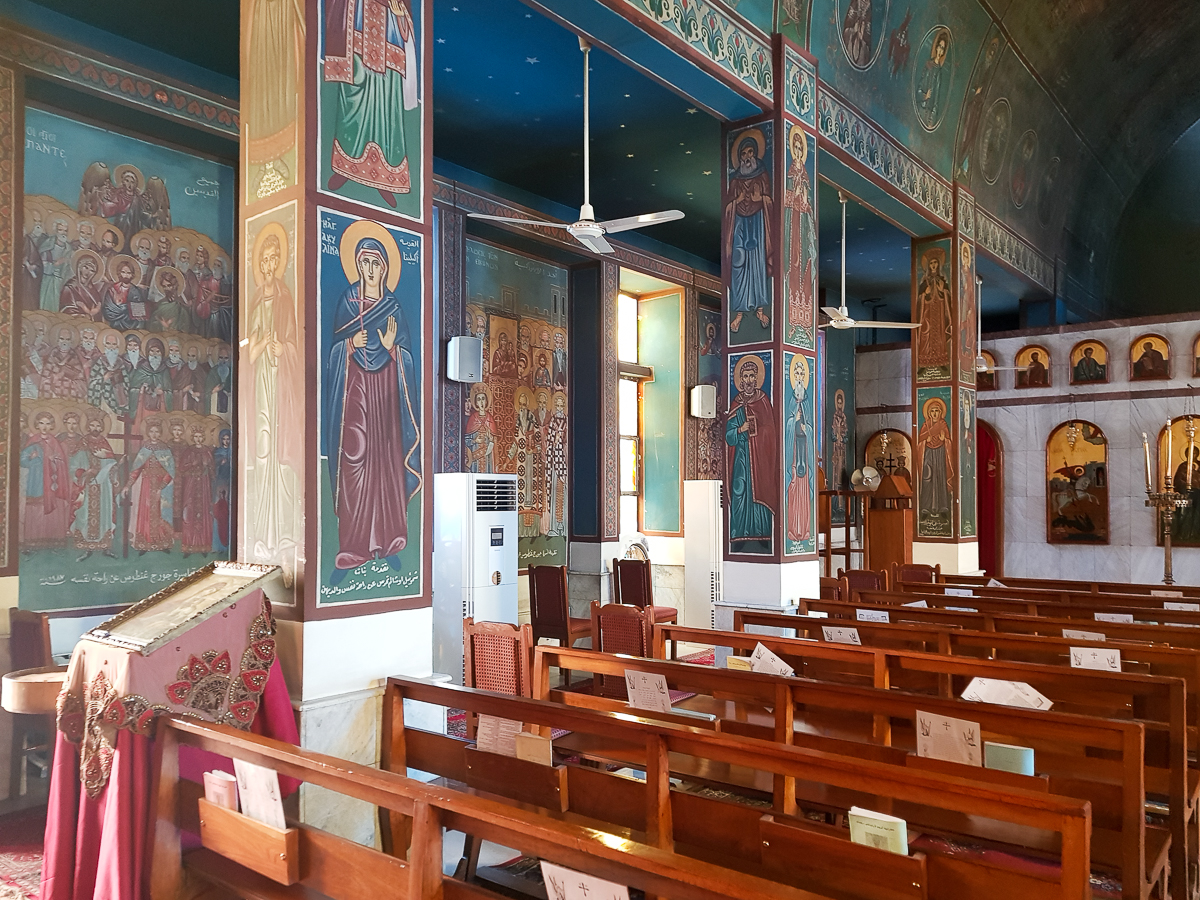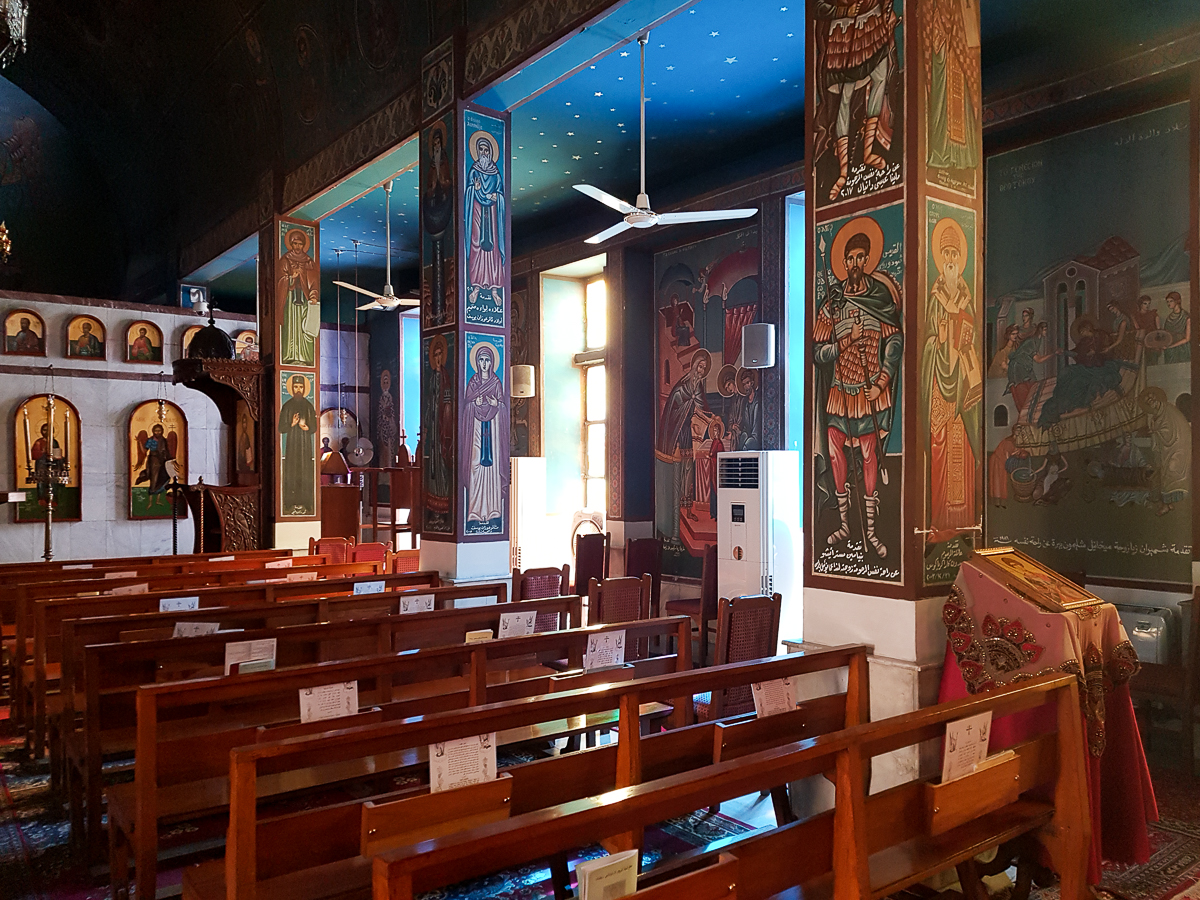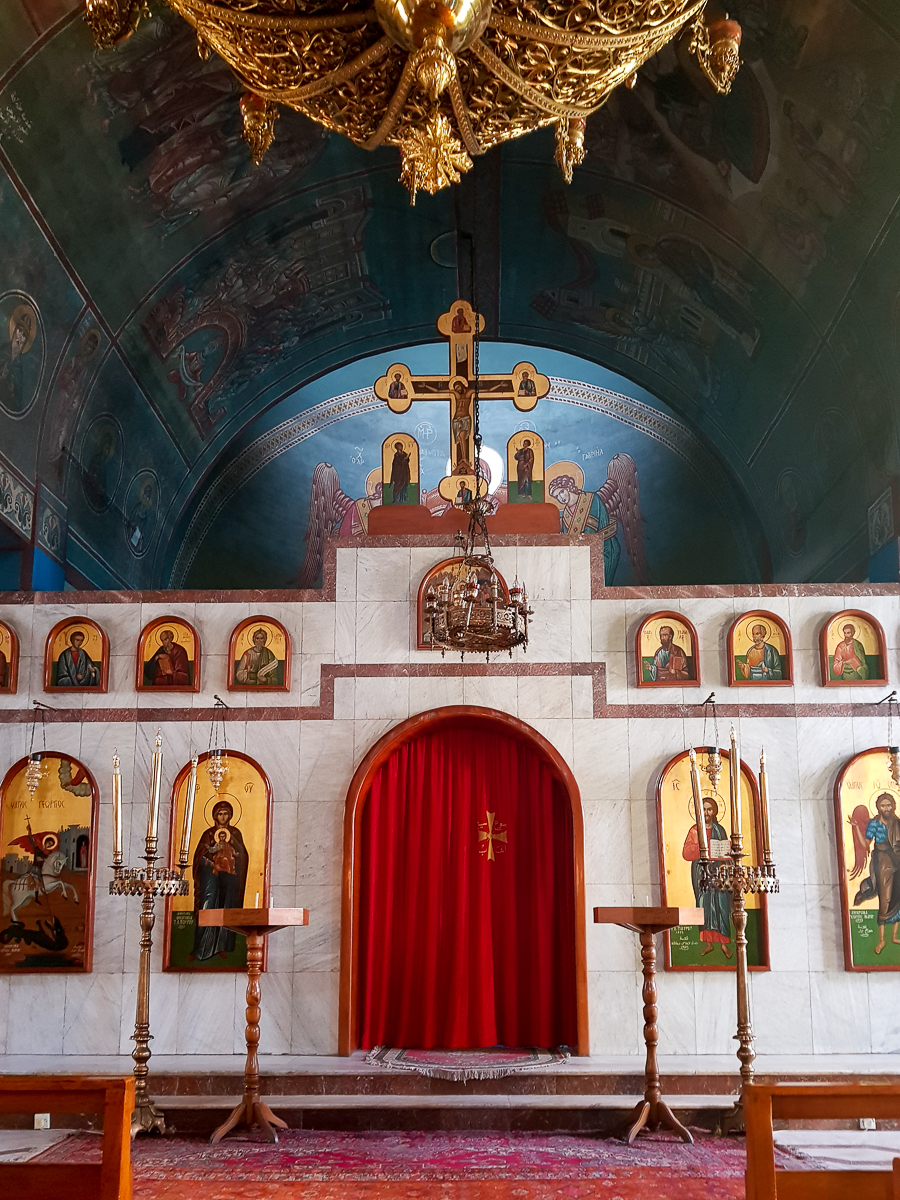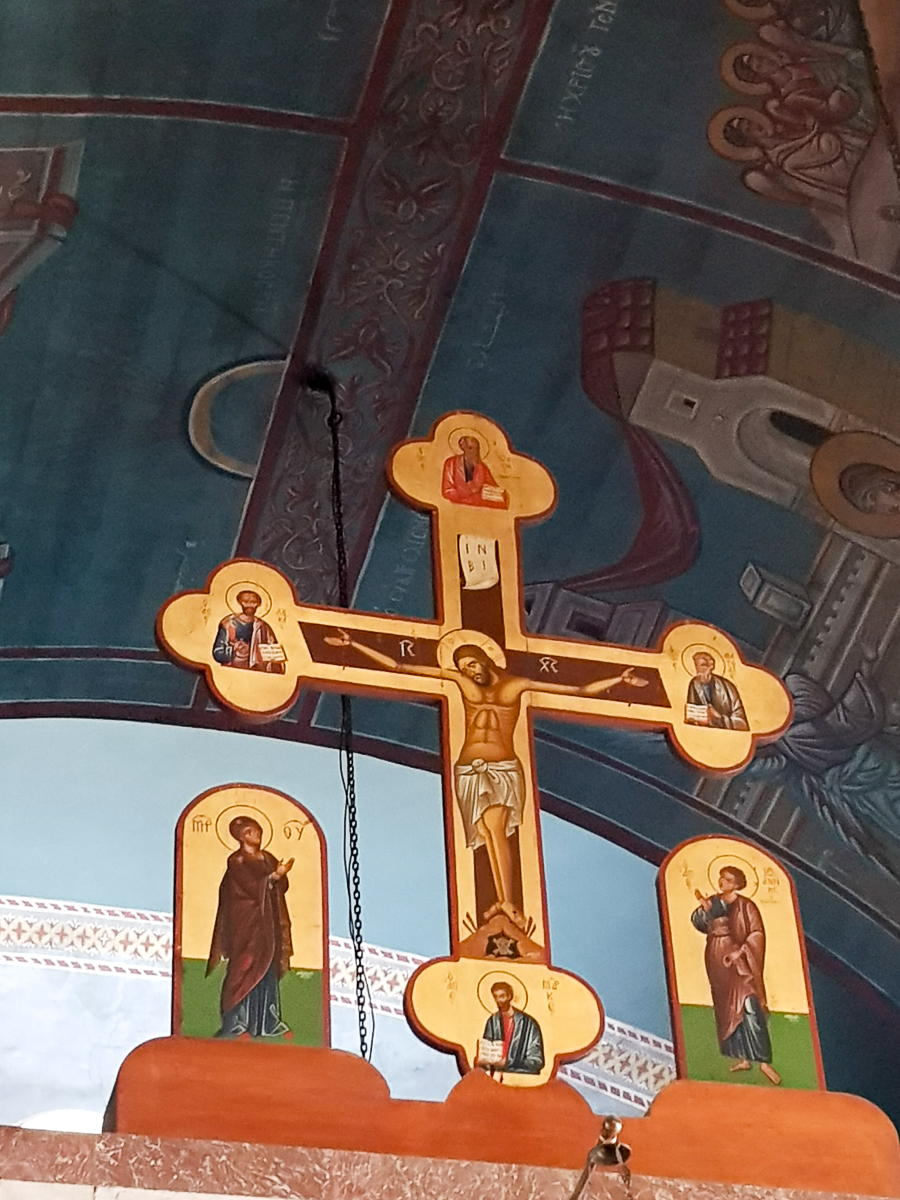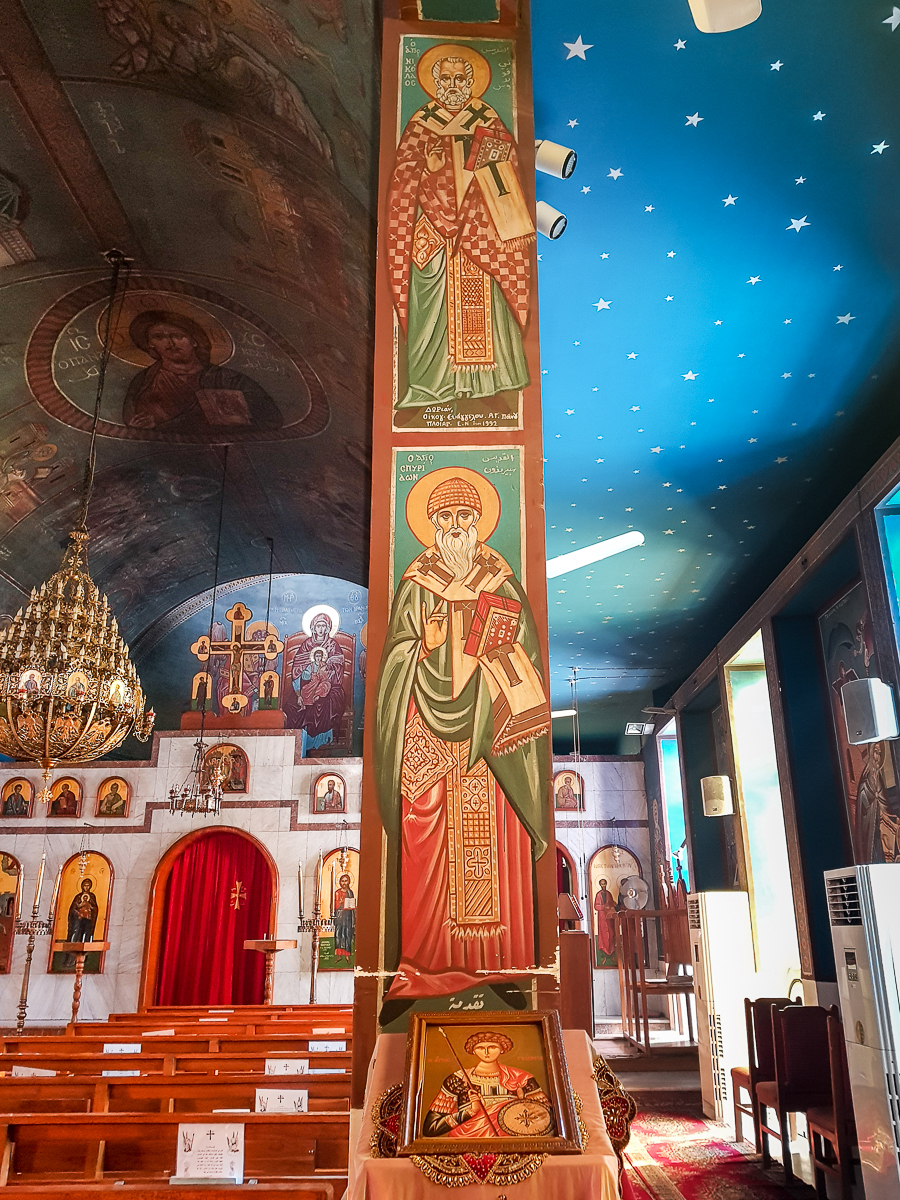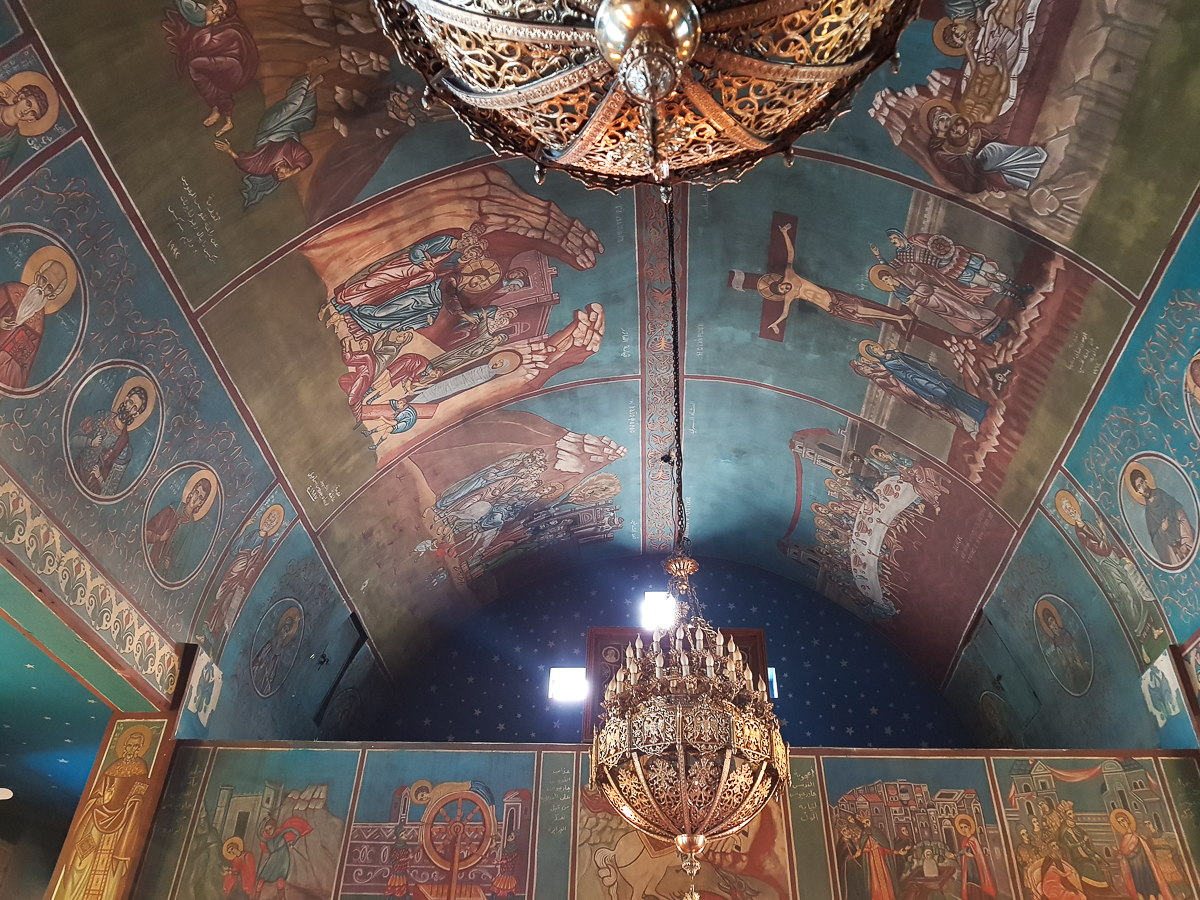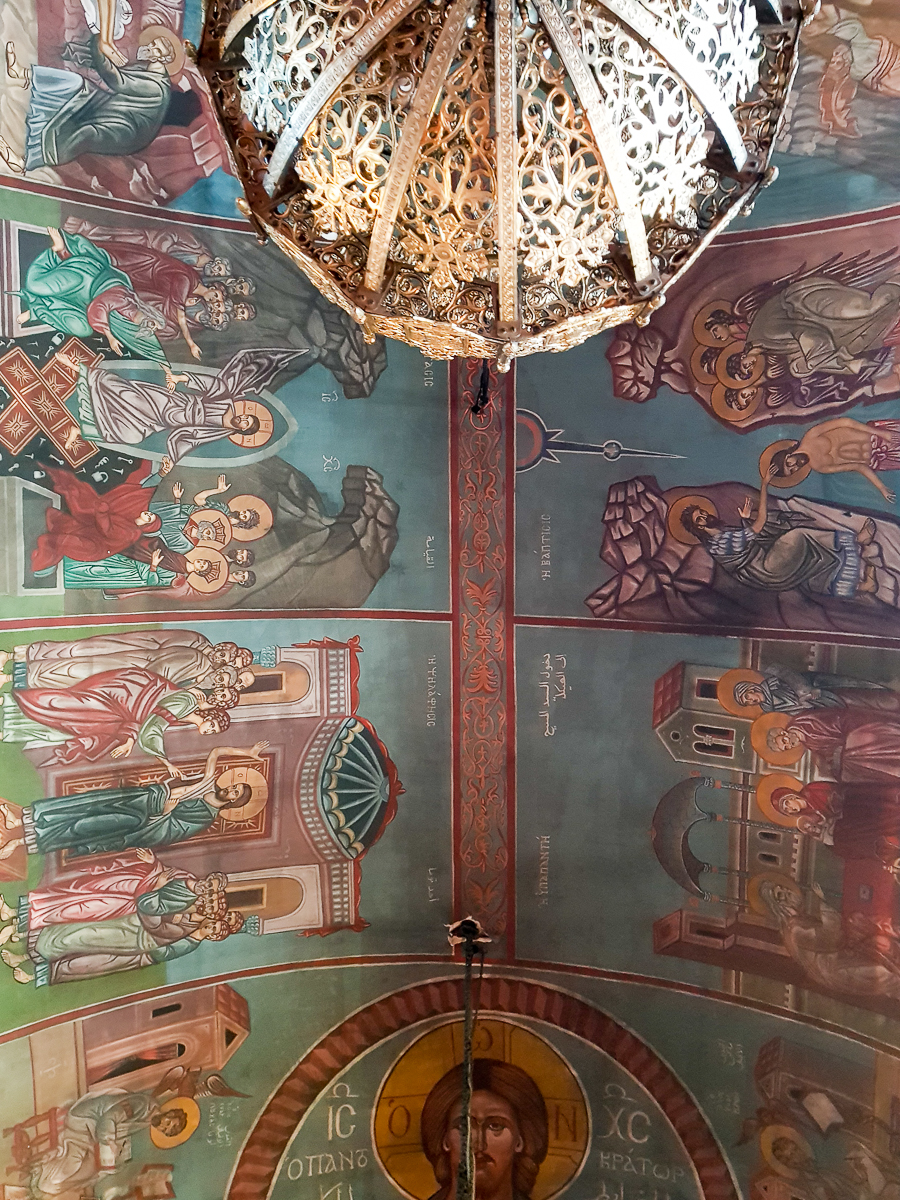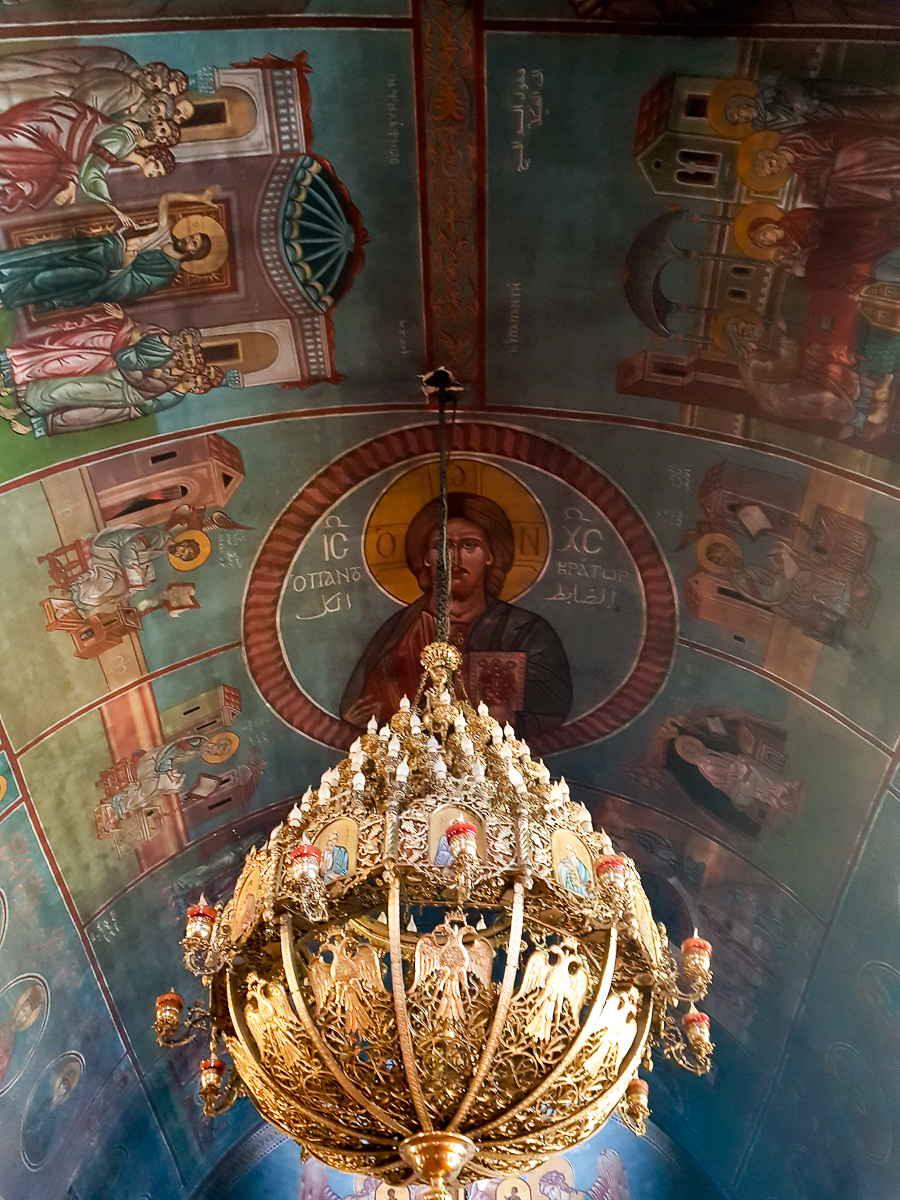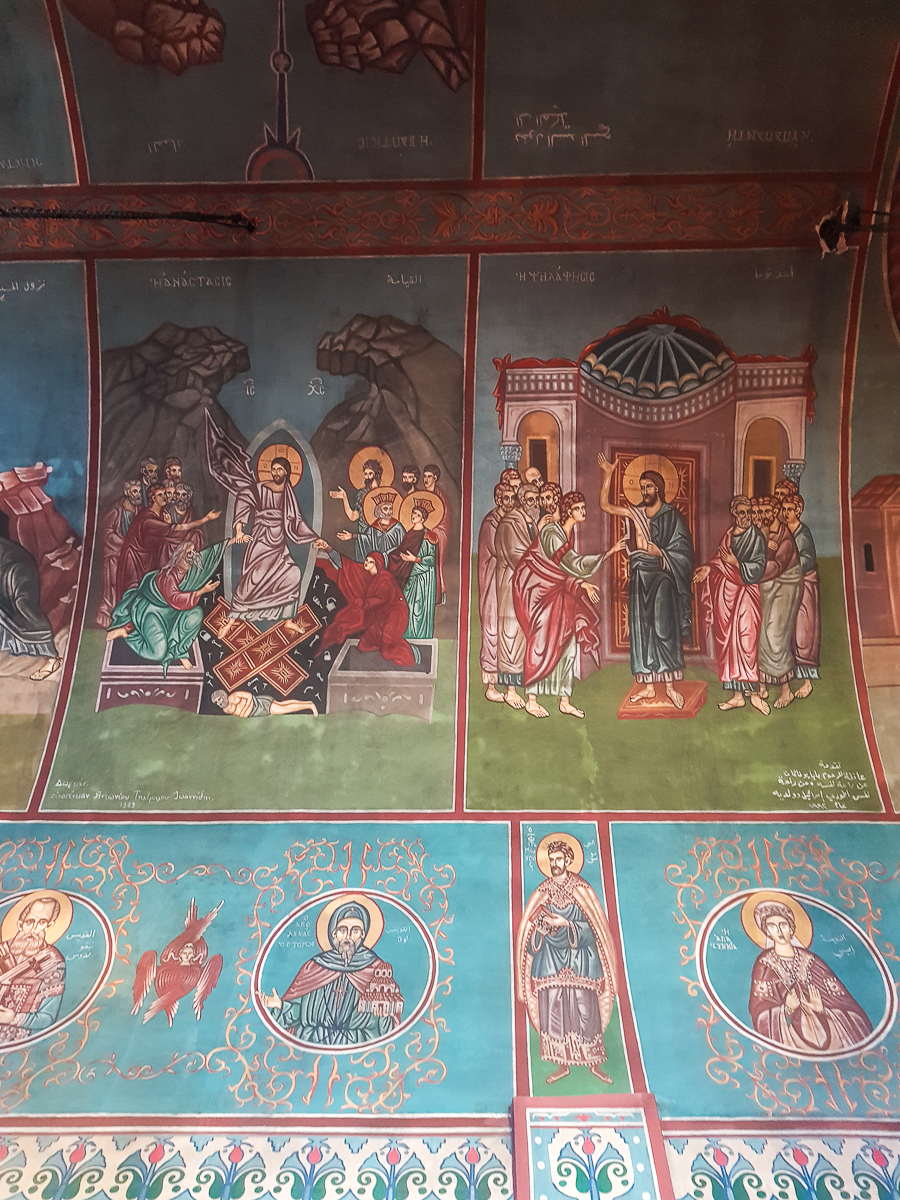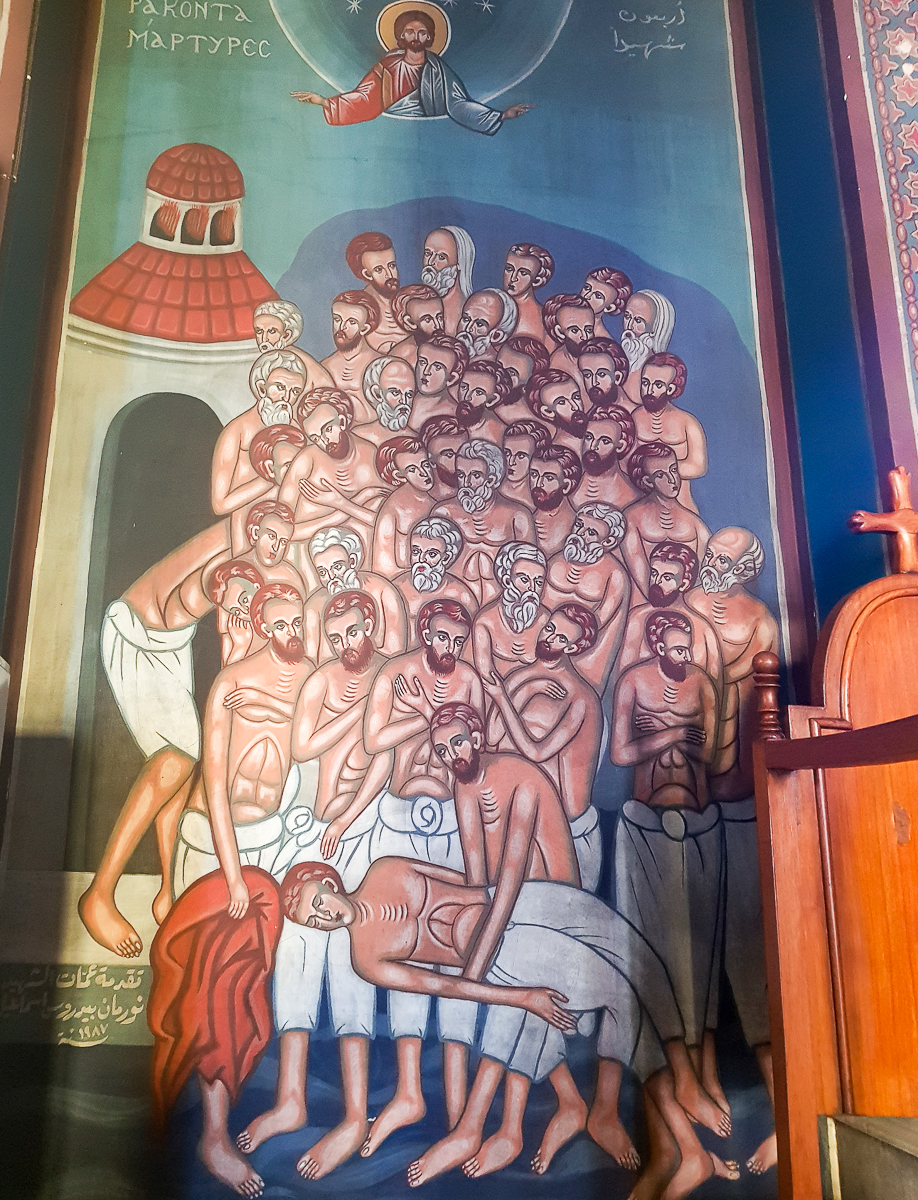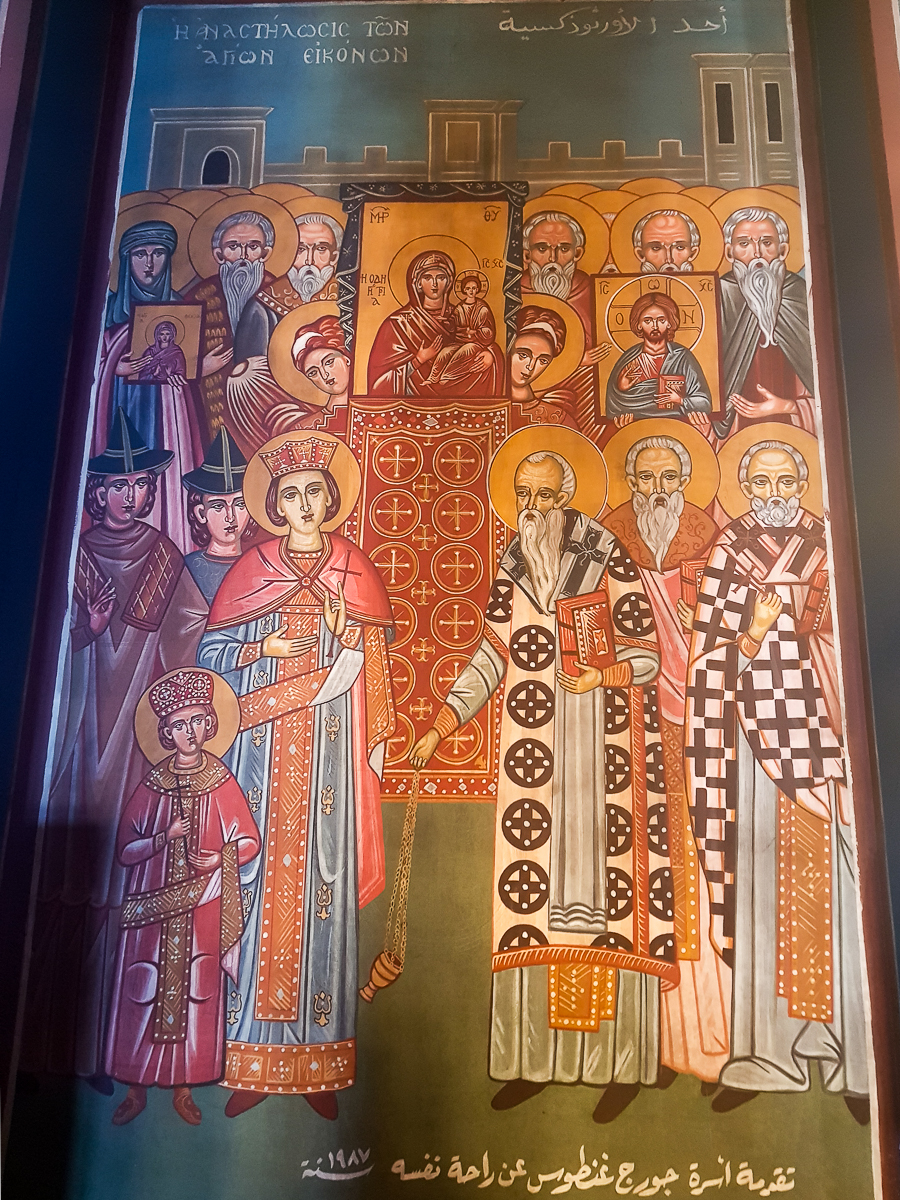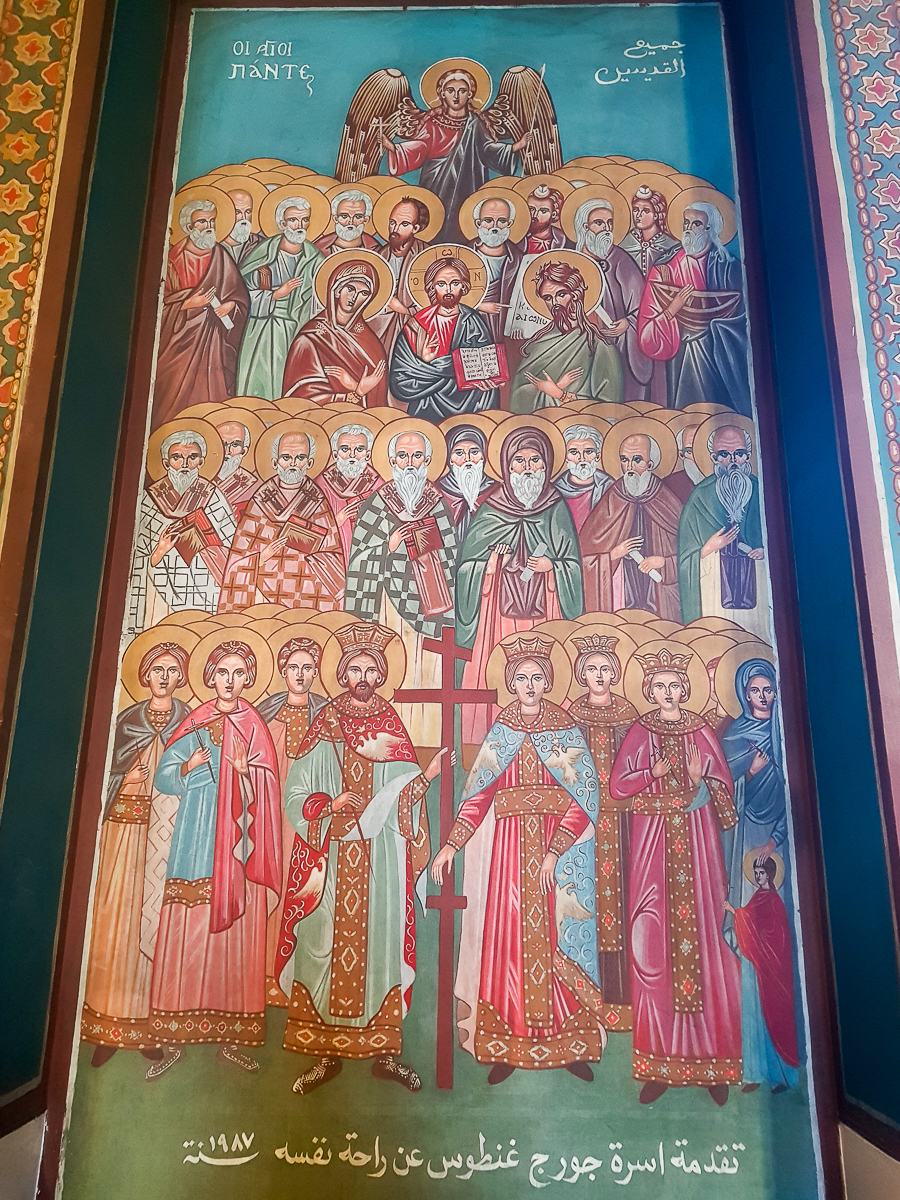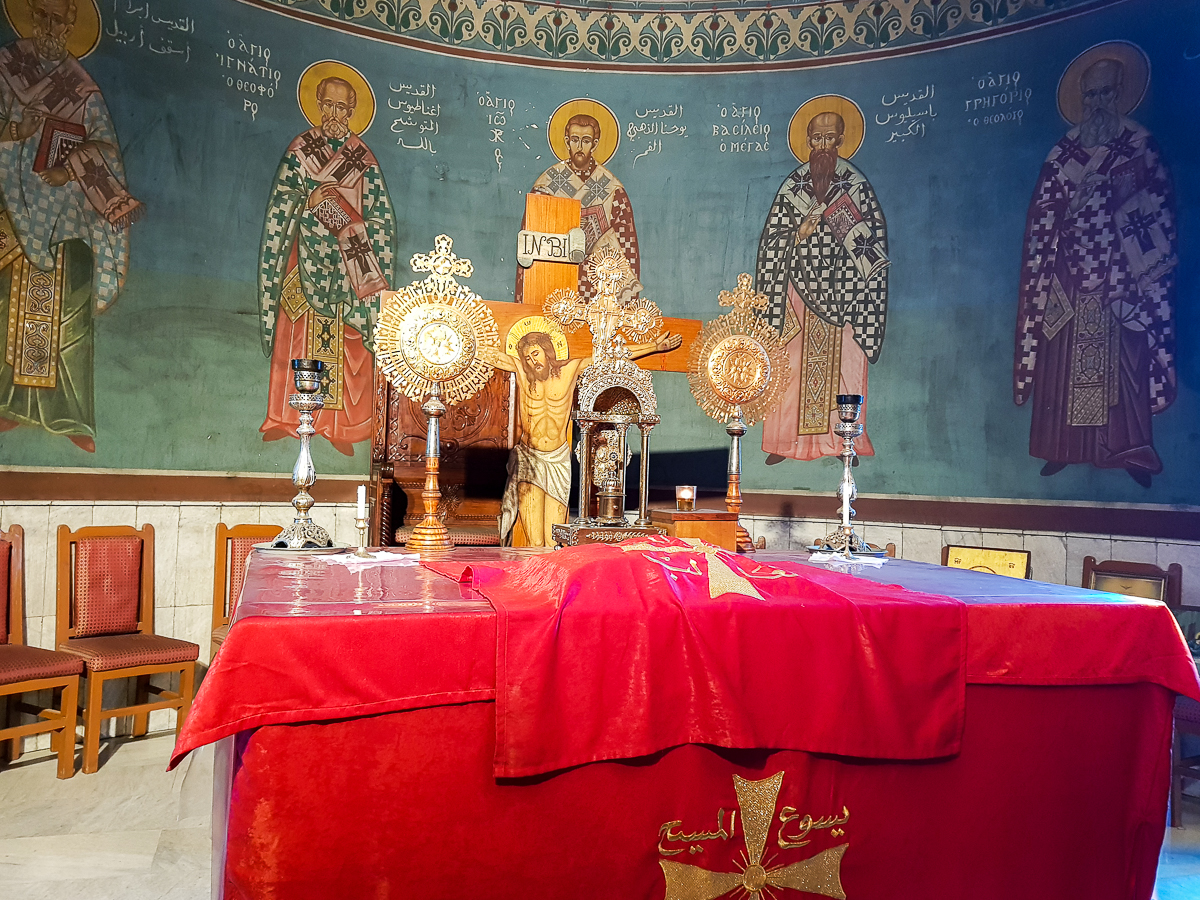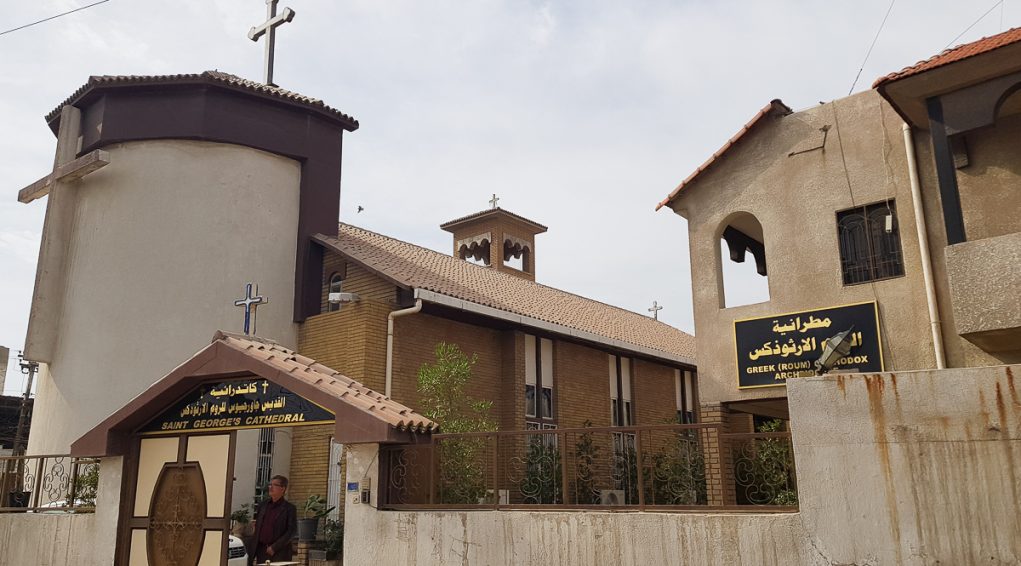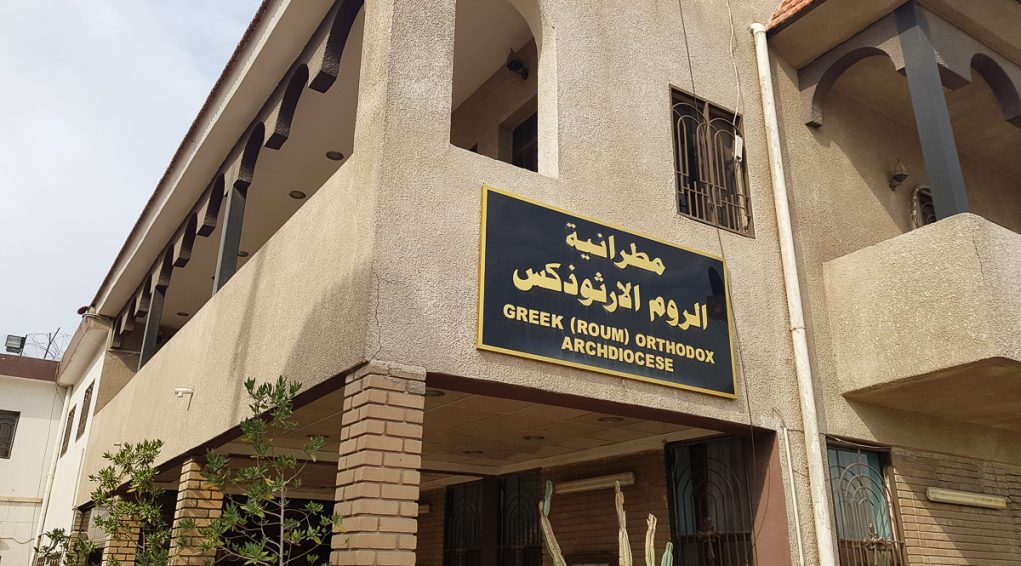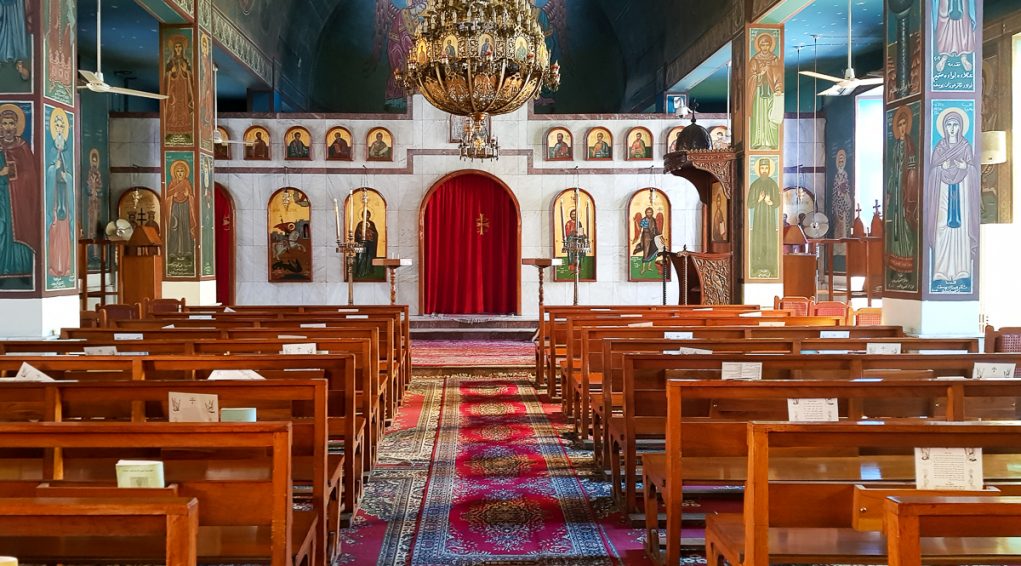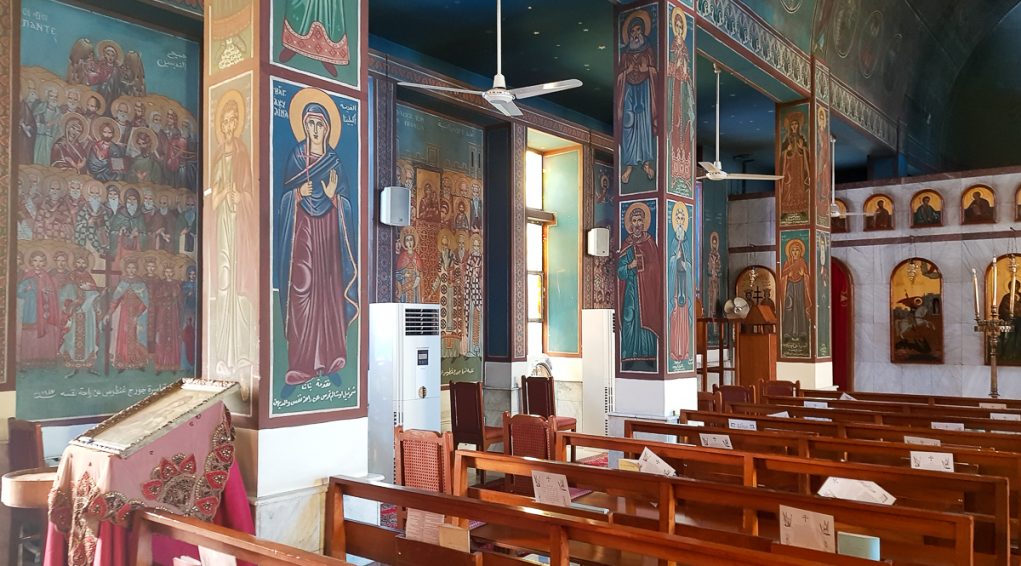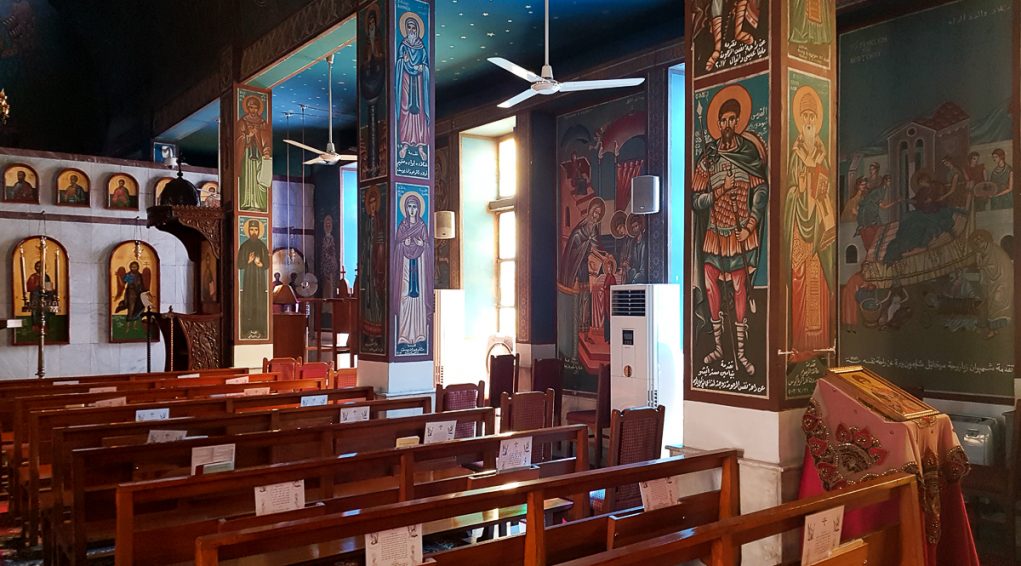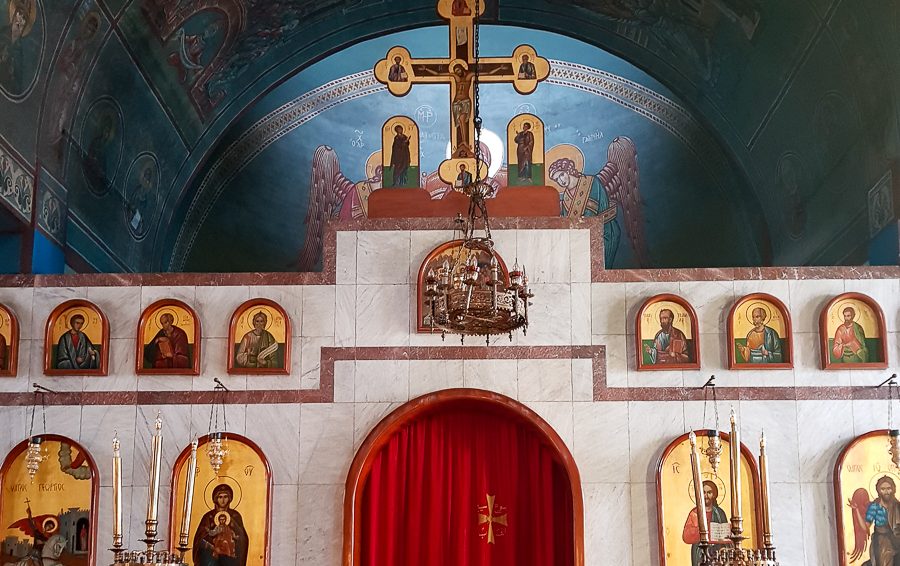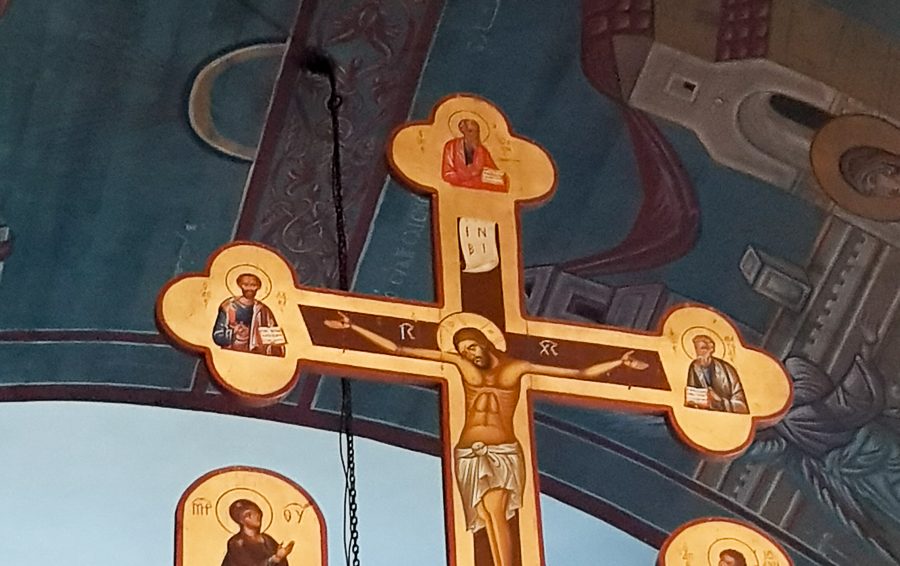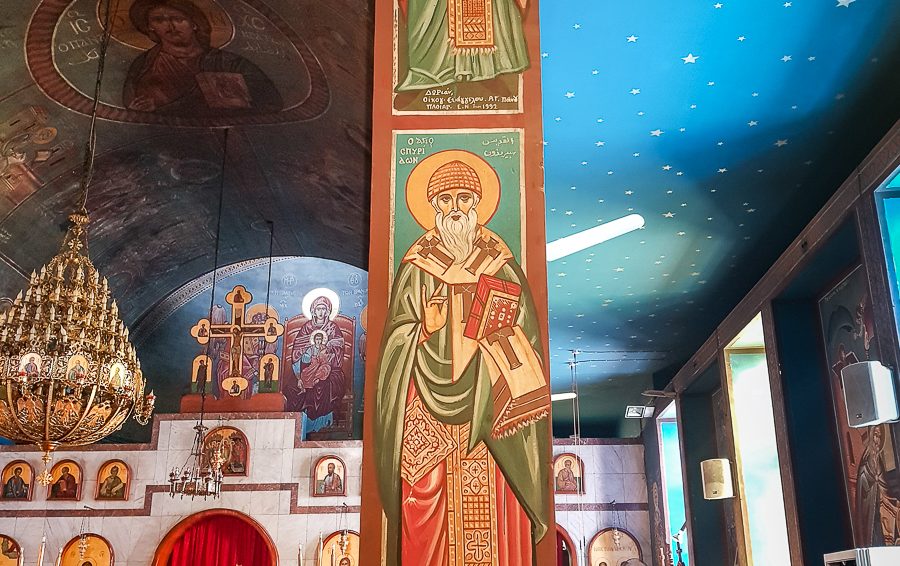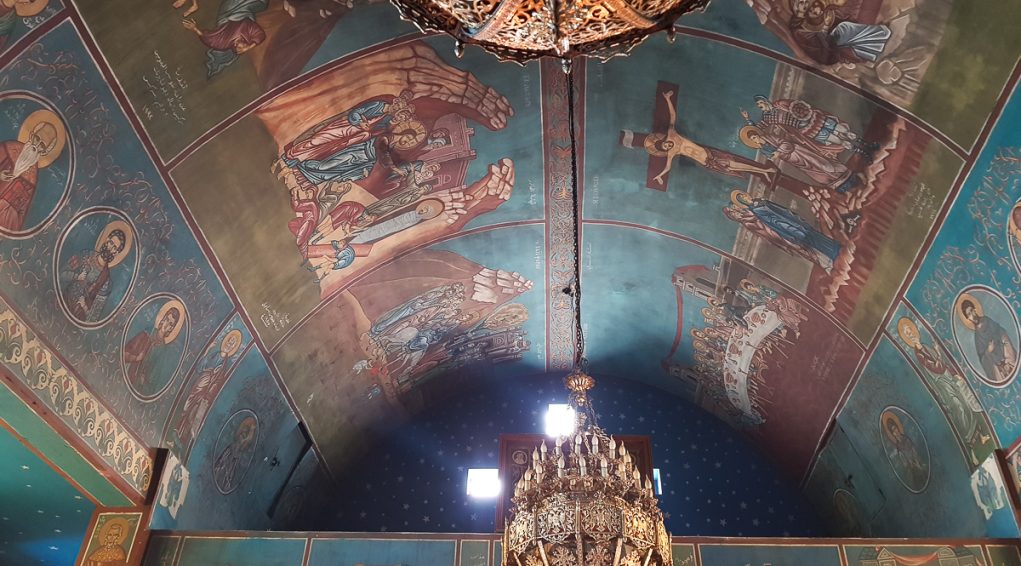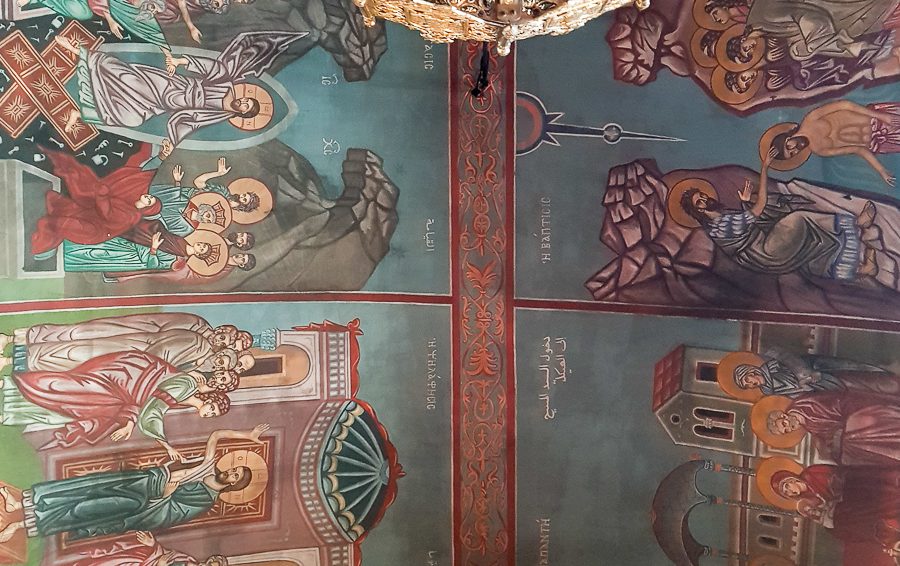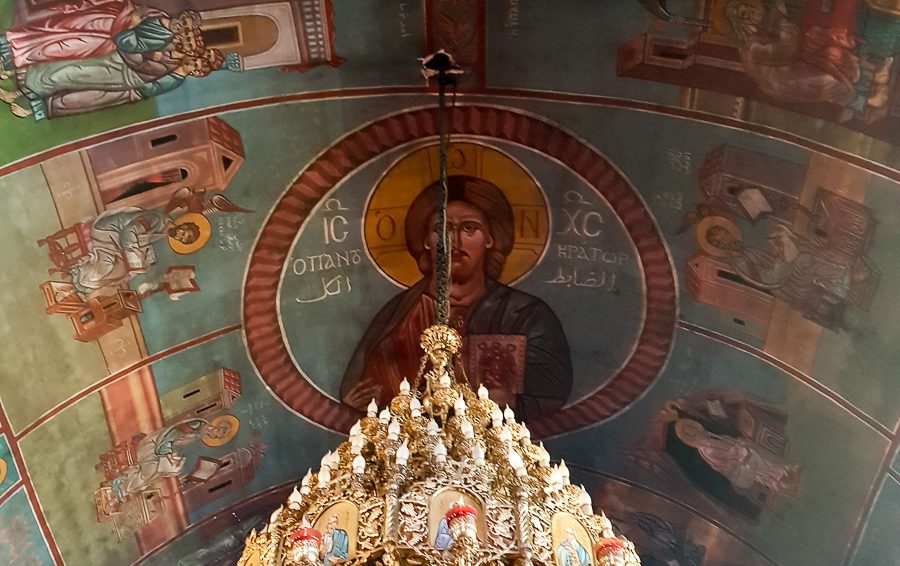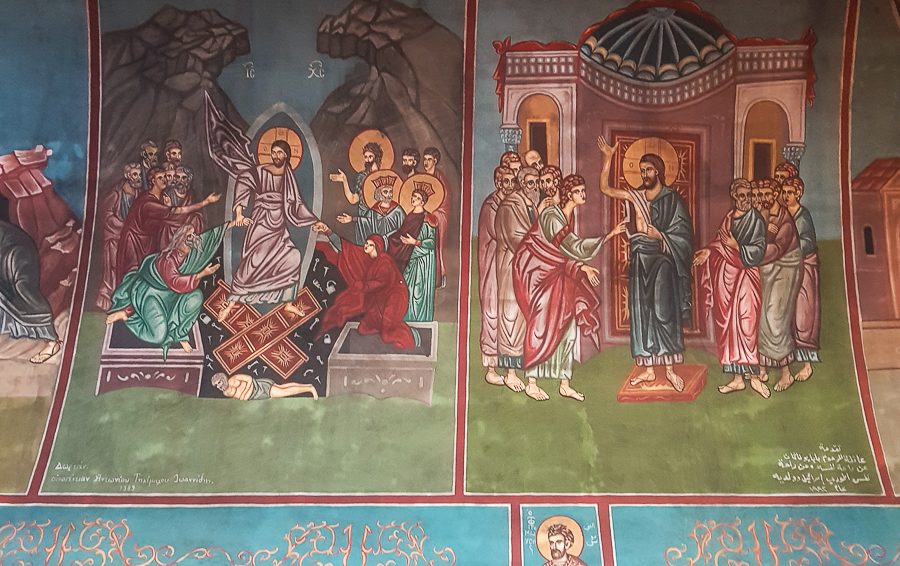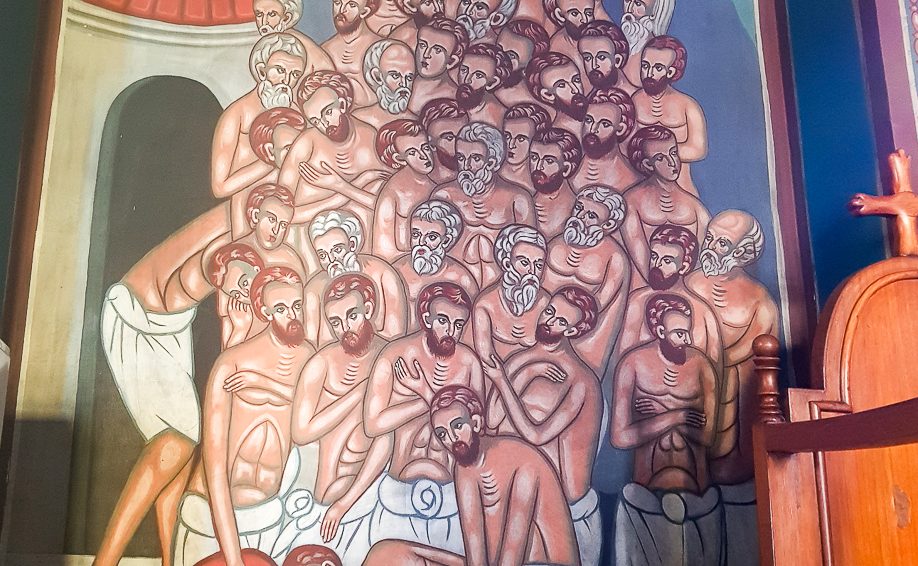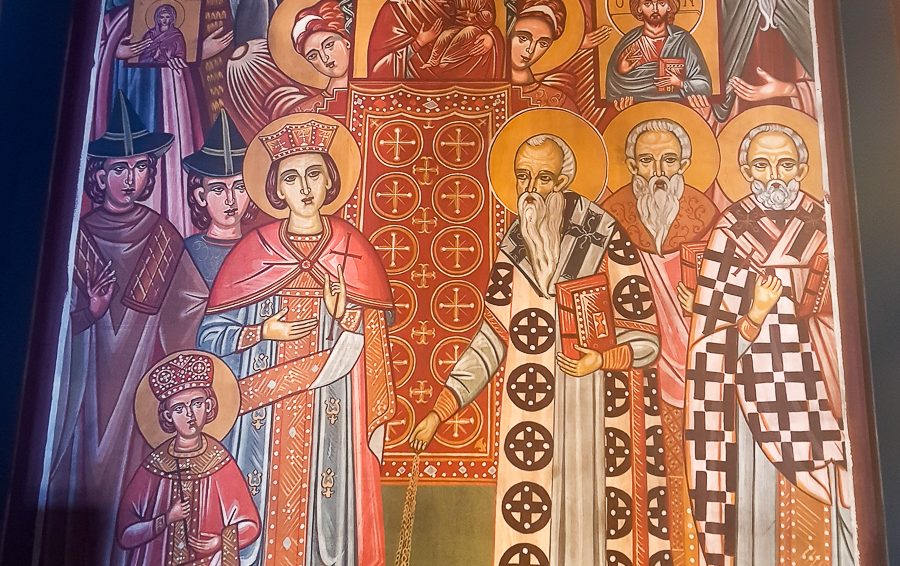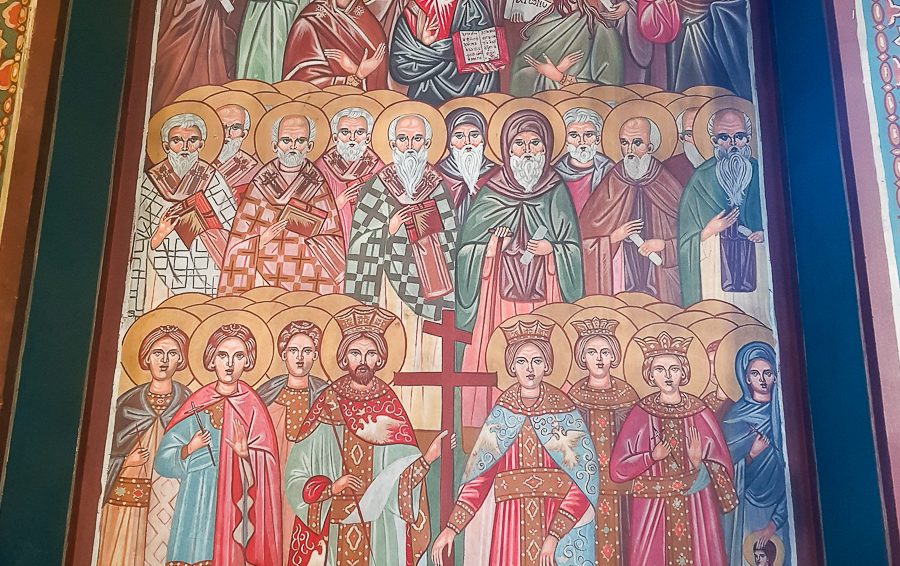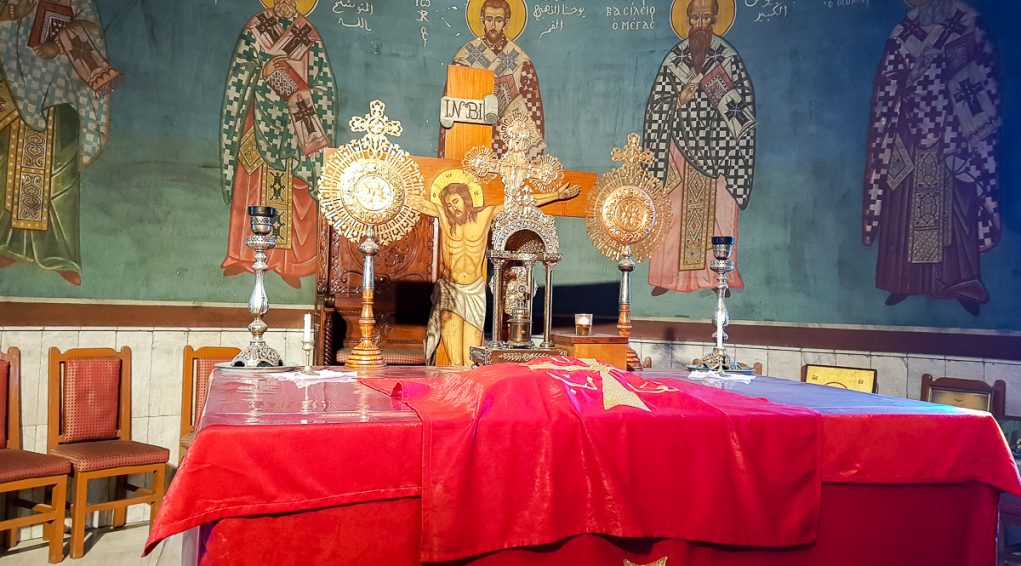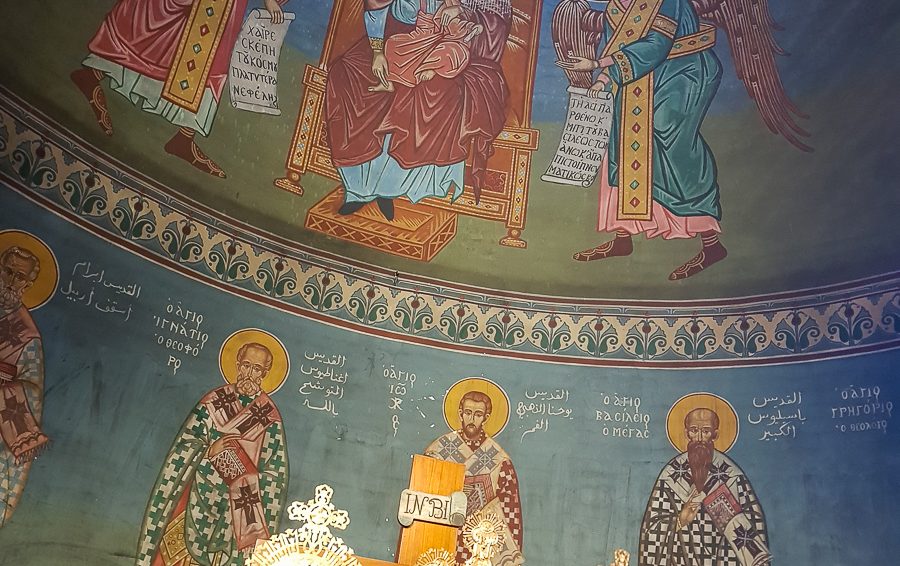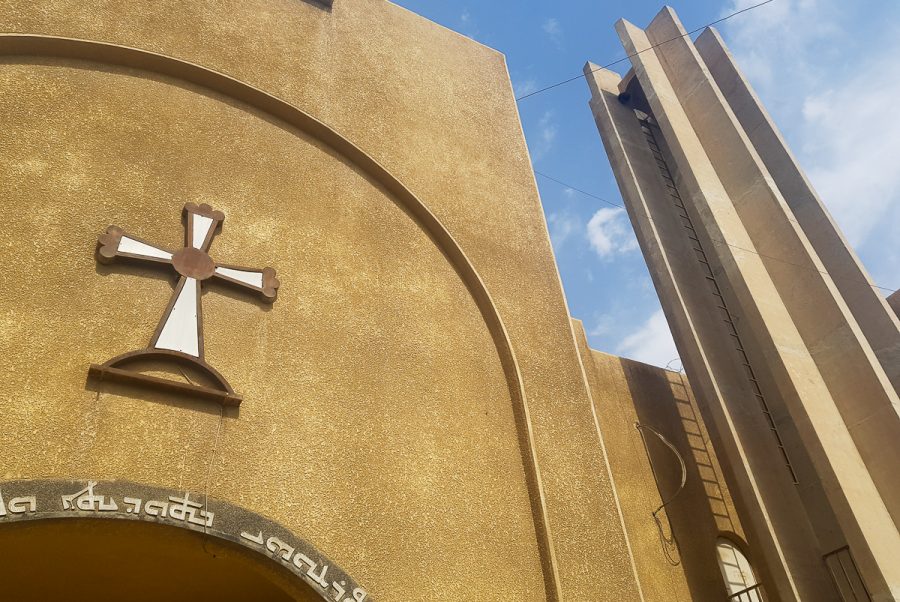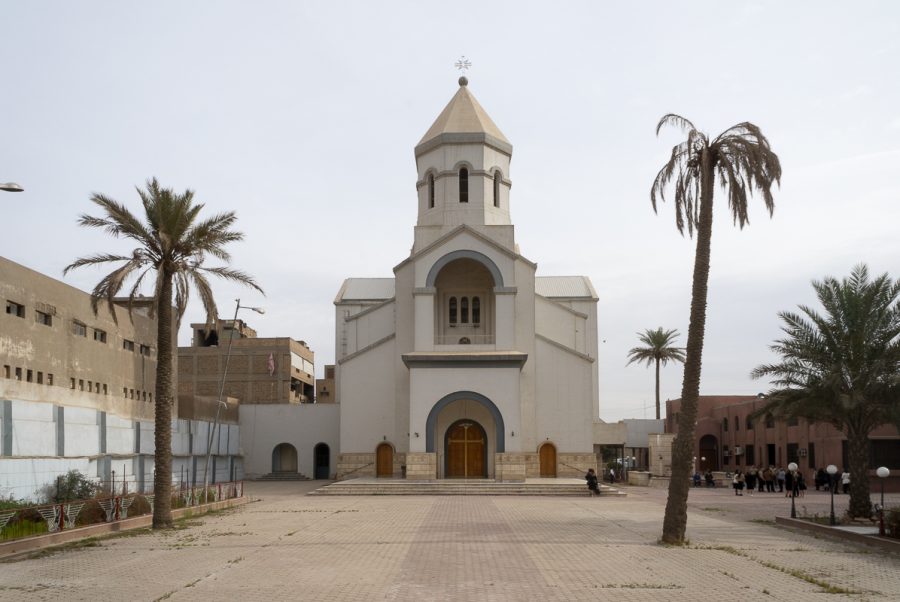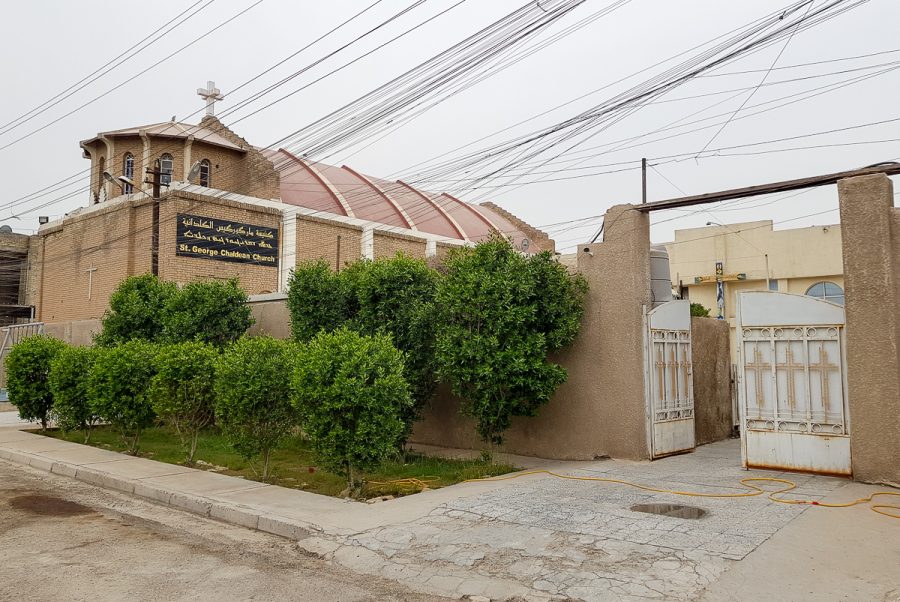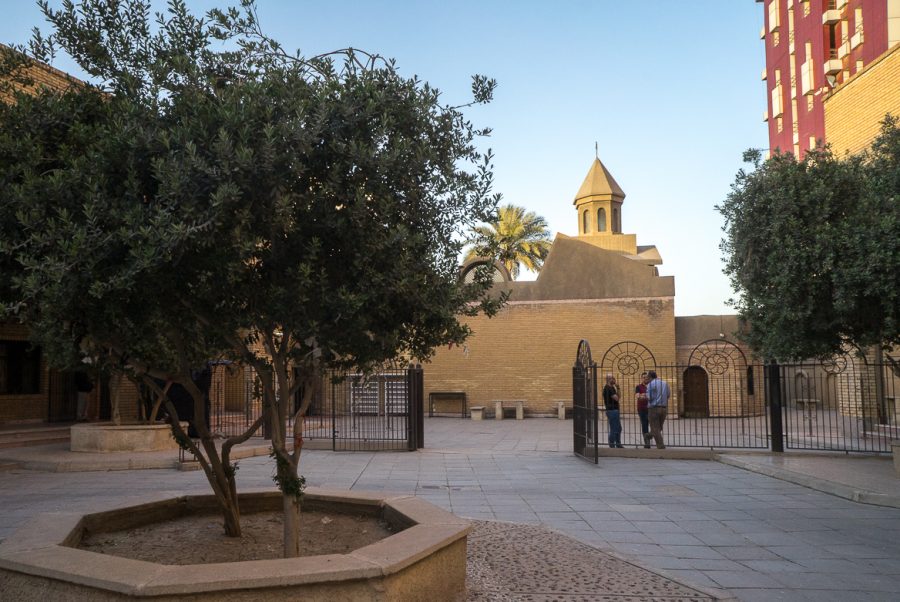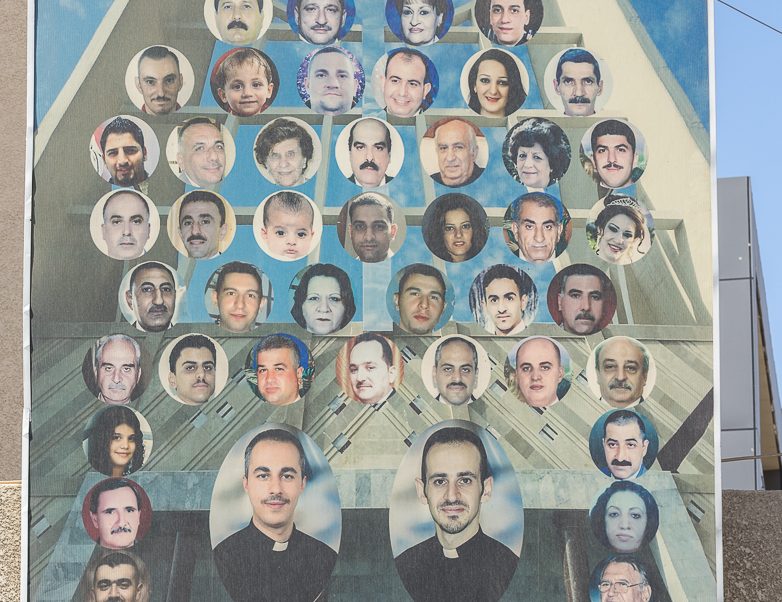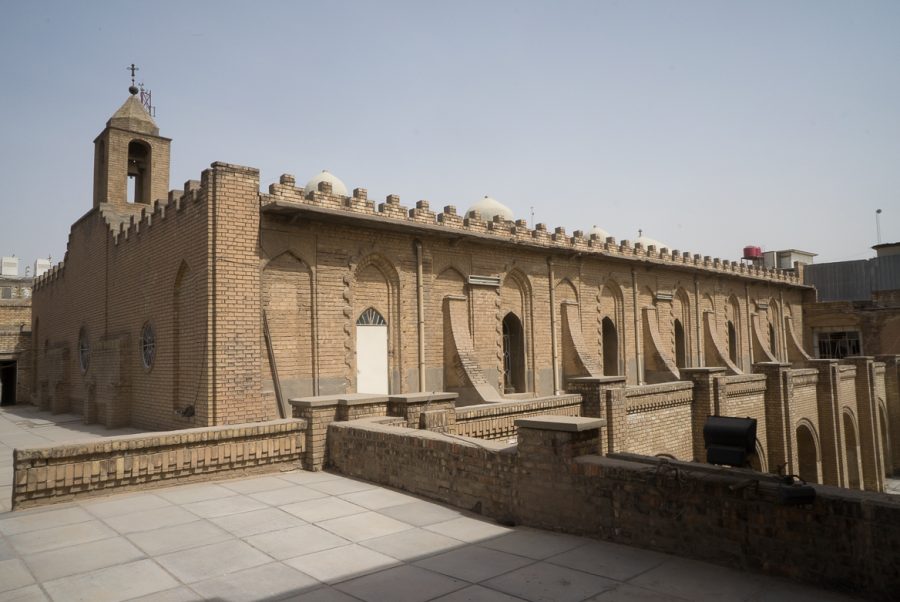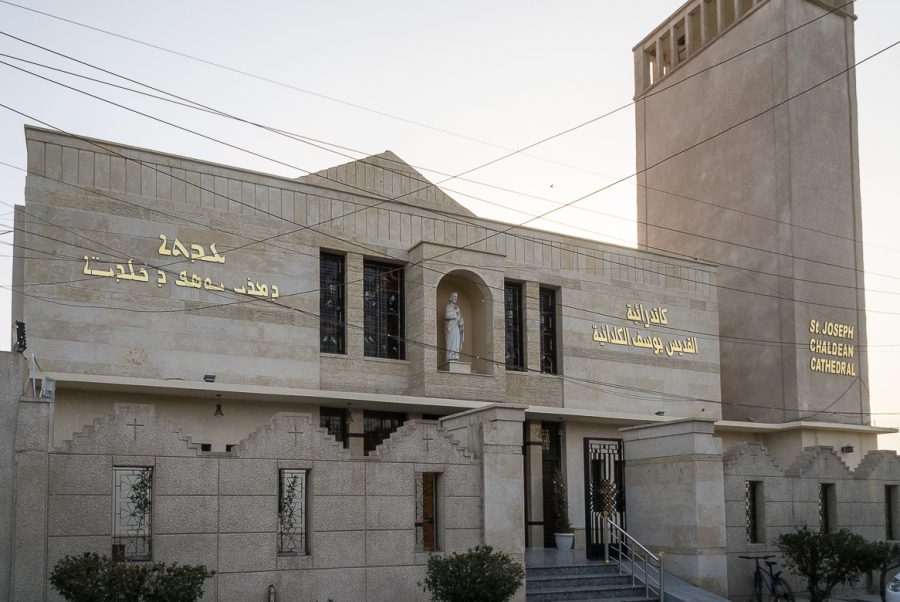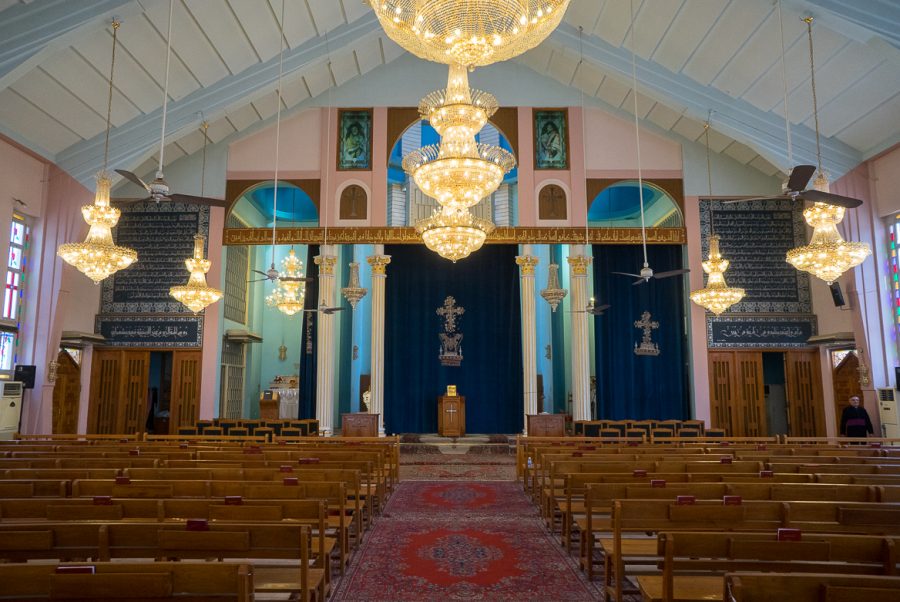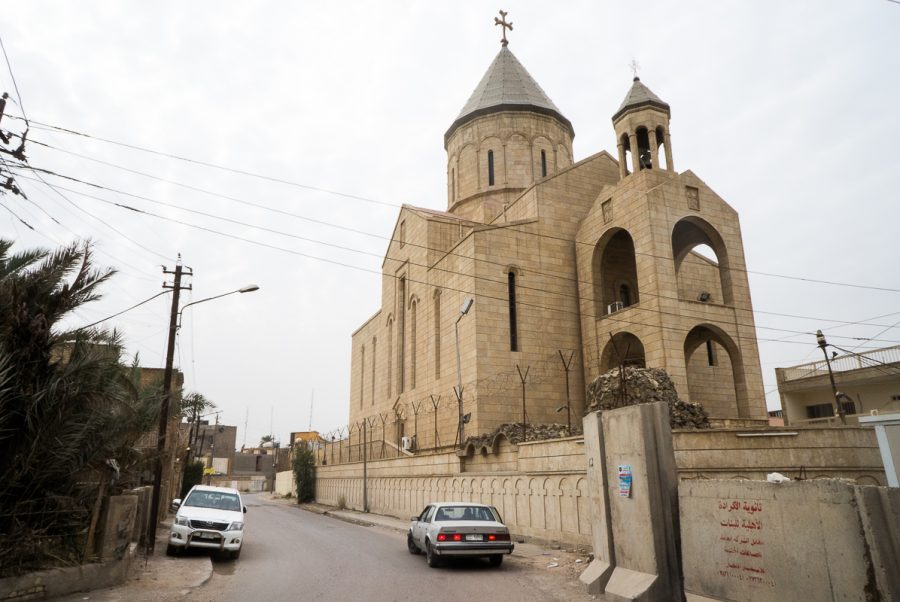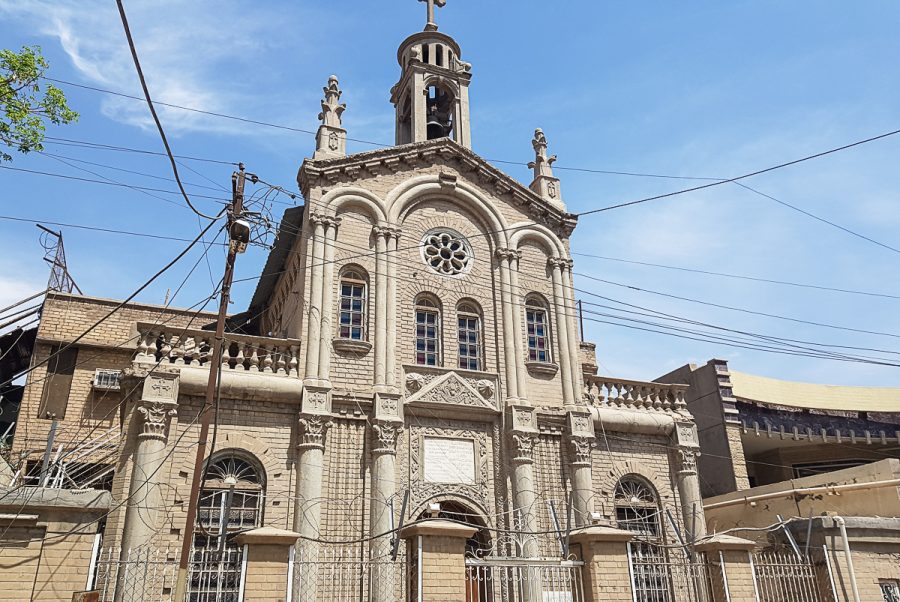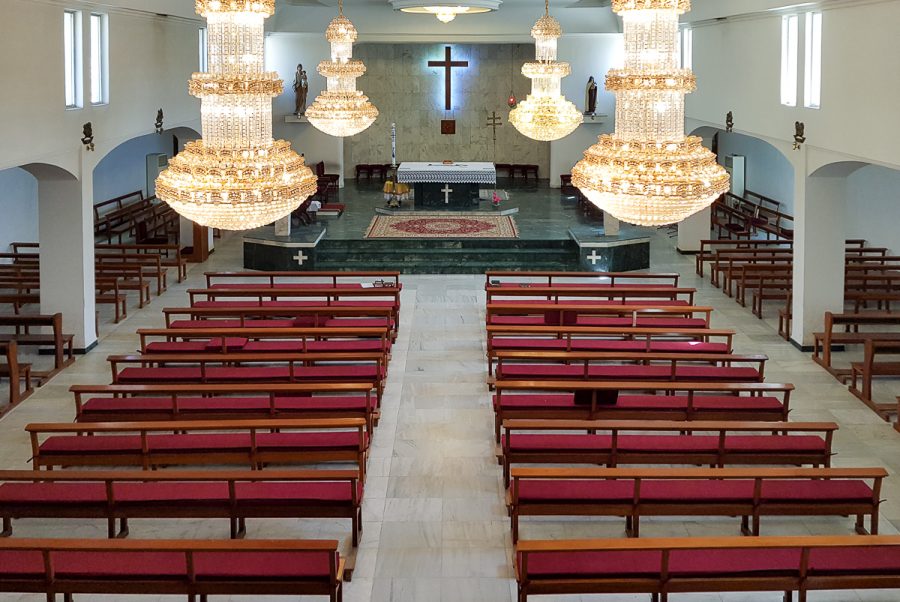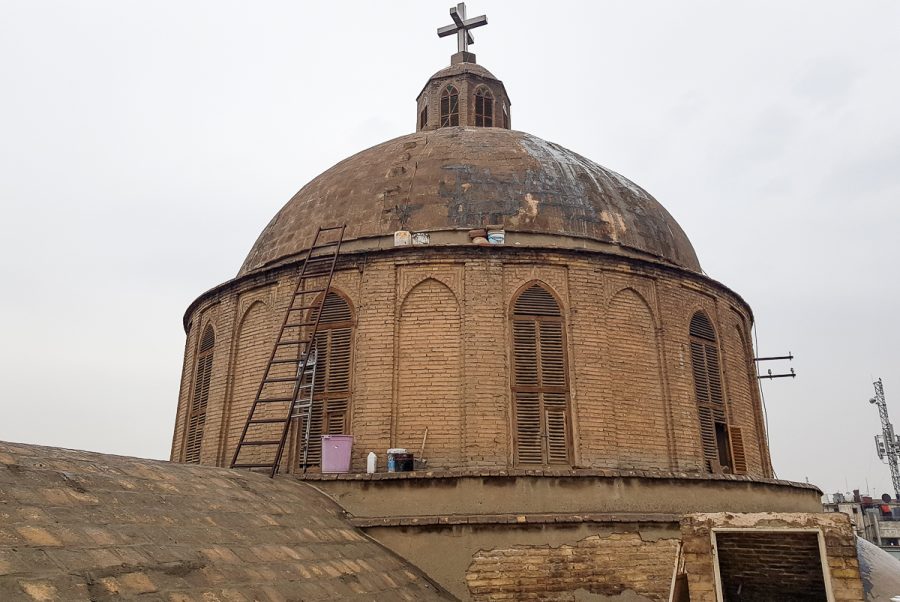The Greek Orthodox Mar Gorgis cathedral in Baghdad
The Greek Orthodox Mar Gorgis cathedral is located at 33°18’2.10″N 44°26’47.20″E and 39 metres altitude, in the Baghdad-Hay Al-Riad district of Baghdad.
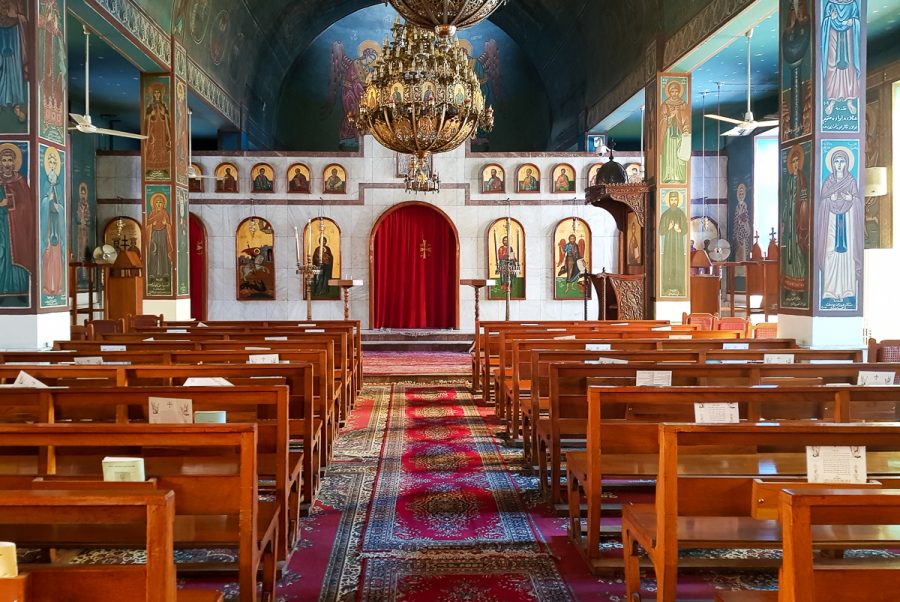
Built by the architect Fahram Strak, the Greek Orthodox Mar Gorgis cathedral in Baghdad was inaugurated in 1976.
Unlike the more minimalist Assyrian-Chaldean churches, the Mar Gorgis cathedral is characterised by its profuse decorative features in the Byzantine-style. The semi-circular vault, the balustrade of the tribune, the walls of the facades and apse, the iconostasis and the pillars are covered in wall paintings and icons representing the different stages of the life of Christ, the apostles, the saints, angels, soldiers, sovereigns, prophets and fathers of the Greek Orthodox church.
Two large chandeliers descend from the celestial vault over the centre aisle. They are very ornately decorated, covered in gold leaf and in line with the Orthodox tradition represent the cosmos and celestial bodies set out around the Holy Trinity.
Pic : The Greek Orthodox Mar Gorgis cathedral in Baghdad April 2018 © Laith Basil Nalbandian / MESOPOTAMIA
Location
The Greek Orthodox Mar Gorgis cathedral is located at 33°18’2.10″N 44°26’47.20″E and 39 metres altitude, in the Hay Al-Riad district of Baghdad, in Tariq Bin Ziao street.
The Greek Orthodox church: fragments of history
The Greek Orthodox church was born out of a schism in 1054 between Rome and Constantinople, the two bastions of Christianity. The Greek Orthodox church is structured around the patriarchates of Constantinople, Antioch, Jerusalem, Cyprus and Alexandria. The dioceses of Lebanon, Syria, Iran, Iraq, Kuwait and the Arabian Peninsula come under the jurisdiction of the patriarchate of Antioch.
Like the Armenians, members of the Greek Orthodox church of Antioch in Iraq are not strictly speaking native Christians, as opposed to the Assyrians, Chaldeans and Syriacs. “Although a diaspora of Christians following the Greek rites formed in Mesopotamia in the High Middle Ages out of the populations displaced by the Iranian and Arab-Byzantine wars, the modern communities are mainly composed of Syrian, Palestinian and Lebanese families who arrived at the start of the 20th century.” [1]
On 16th March 1942 in Beirut, in the midst of the second world war, 16 Greek Orthodox Syrian and Lebanese intellectuals and students created the Orthodox Youth Movement to rethink and organise the revival in the Greek Orthodox church of Antioch across all its dioceses, including Baghdad. The former Greek Orthodox Patriarch of Antioch Ignatius IV Hazim, was one of the founders.
At the end of the second world war, Arab nationalism had become the new dominant political model. Some Arab Christians contributed to this, focusing on “merging communities around a shared Arab identity[2]”, convinced that “a modernised, more open society would also be for them[3].” The best known and the most zealous of these was the Syrian Michel Aflaq whose mausoleum is located in Baghdad. A member of the Greek Orthodox community, he co-founded the Baath party in April 1947, urging Arab Christians to get actively involved in this socialist, secular, pan-Arabic movement, whilst placing Islam and its values not only at the centre of Arab identity but also above any other heritage.
From 2003 onwards, along with all the indigenous Christian communities, the Greek Orthodox in Iraq were hard hit by the Islamic fundamentalism which emerged in the pervading state of institutional chaos. It would appear that the Greek Orthodox community in Iraq was composed of no more than 30 families in Baghdad in 2014, as opposed to 600 before the invasion of Kuwait in 1991.[4] In Mosul, the last 10 Greek Orthodox families were forced out of their homes. There are no more Greek Orthodox in Basra.
The Greek Orthodox church of Antioch owns two churches in Baghdad including the Mar Gorgis cathedral, a school, an old people’s home, an orphanage and a space devoted to sports, cultural and educational activities.
Patriarch of the Greek Orthodox church of Antioch and all the East[5], John X of Antioch, elected on 17th December 2012, was consecrated on 10th February 2013. He succeeded the Patriarch Ignatius IV Hazim.
Since 2015, the Greek Orthodox diocese of Baghdad (and Kuwait) has been headed up by Monsignor Ghattas Hazim. Born in Hama in Syria, he is the nephew of the late Patriarch Ignatius IV Hazim.
_______
[1] In “Vie et mort des chrétiens d’Orient”, Jean-Pierre Valogne, published by Fayard, 1994, p.755
[2] Id. p.103
[3] Id. p.103
[4] Source Monsignor Ghattas Hazim, bishop of the Greek Orthodox diocese of Baghdad and Kuweit. This assessment is corroborated by Jean-Pierre Valogne, in “Vie et mort des chrétiens d’Orient” (p.755), who, in 1994, reported that there were 2,500 Greek Orthodox in Iraq.
[5] Full title
Description of the Greek Orthodox Mar Gorgis cathedral in Baghdad
Built by the architect Fahram Strak, the Greek Orthodox Mar Gorgis cathedral in Baghdad was inaugurated in 1976.
On entering the estate via the entrance door, immediately to the right is a small courtyard surrounded by the archdiocese buildings and to the left is the cathedral itself. Seen from the exterior, the Mar Gorgis cathedral is built of reinforced concrete, with brick facing, covered with a dual-slope tiled roof, in the middle of which is a small, square bell tower. To the east of the building is a semi-spherical radiating apse chapel onto which a large cross has been fixed.
Seen from the interior, the Mar Gorgis cathedral is laid out like a basilica with the nave and two side aisles separated by square pillars. To the west is a tribune above the entrance and to the east a sanctuary preceded by an iconostasis with three curtained doors.
The Byzantine-style decoration of the Mar Gorgis cathedral is remarkable. The semi-circular vault, the balustrade of the tribune, the walls of the facades and apse and the pillars are covered in wall paintings and icons representing the different stages of the life of Christ, the apostles, the saints, angels, soldiers, sovereigns, prophets and fathers of the Greek Orthodox church. The iconostasis which is characteristic of the Greek Orthodox tradition is also decorated with traditional icons used in the Greek Orthodox church.
Two huge chandeliers descend from the celestial vault over the centre aisle. They are very ornately decorated, covered in gold leaf and in line with the Orthodox tradition represent the cosmos and celestial bodies set out around the Holy Trinity.
Unlike the more minimalist Assyrian-Chaldean churches, the Mar Gorgis cathedral is characterised by its profuse decorative features in the Byzantine-style. All the paintings were produced by the artist Antoine Papastephanou, brother of the former Greek Orthodox Metropolitan in Baghdad, Constantin Papastephanou (1969 – 2014).
Monument's gallery
Monuments
Nearby
Help us preserve the monuments' memory
Family pictures, videos, records, share your documents to make the site live!
I contribute
